Request a Brochure
Please complete all required fields!

Saved Tours
{{item._source.name || item._source.title}}.
- local_phone +44 (0) 1962 733051
- Our Holidays
- Brochures and Newsletters
- Tour Leaders
- Job Vacancies
- Complete Financial Protection
- Book a Naturetrek speaker
- The Naturetrek Reserve
- Naturetrek's History
- Private Groups
- Sustainable Tourism

Tour Itinerary and Reports
Can i help you.

The Best of Sierra Leone
A 19-day holiday to this less visited west African country in search of birds and mammals, including some endemic and regional endemic species, taking in varied habitats from coast to forest and savannah to river.
Quick Enquiry
Quick enquiry.
Sierra Leone is a name that many people are familiar with; however, few are aware of the diverse range of wildlife that can be found in this less visited west African country. With habitat ranging from coastal estuaries to grasslands and lush forests, we can expect to find a superb variety of birds and mammals. Well over 600 species of birds have been recorded here, including all 14 of the Upper Guinea Forest endemics, along with over 200 mammal species, roughly 750 butterflies, over 2,000 higher plant species and around 100 species of reptiles and amphibians combined. Among the more unusual of these are the shy Pygmy Hippopotamus, the prehistoric- looking White-necked Rockfowl (Picathartes), Rufous Fishing Owl, Gola Malimbe, Diana Monkey, Forest Elephant, rare wintering Pallid Harrier, Turati’s Boubou, Africa’s largest butterfly, the African Giant Swallowtail, and other endemic and regionally endemic species.
- Visit less known national parks for a diverse range of species
- Search for Picathartes and regional endemic birds
- Abundant wildlife (over 600 bird species and more than 200 mammal species recorded in Sierra Leone!)
- Primate hot spot, with over 10 species possible
- Stunning beaches along the coast
- Off the beaten track
There is a reasonable amount of walking included in this tour, including over some rougher and steeper terrain. On a number of days there will be long drives, some of which will be over uneven surfaces.
Outline Itinerary
What's included.
A mix of accommodation is used on this tour. Hotels or guesthouses will be used on some nights, which will range from fairly basic, but comfortable to more upmarket, but all with en suite facilities. During the days at Outamba Kilimi, Gola and Tiwai we will be using tents and shared facilities; sleeping mats are provided, but sleeping bags and liners should be brought.
All meals from an evening meal on Day 1 to breakfast on Day 18 are included in the cost.
Dates & Prices
Prefer to travel in a private group.
For any interested natural history club or society, we can arrange for a private departure of this tour.

Why Naturetrek?
At Naturetrek we craft expertly-guided group and tailor-made wildlife holidays and cruises to all seven continents. On one of our holidays, you can be assured that our passionate team will enable you to experience and enjoy the best of the world's wildlife and natural spectacles in as comfortable and rewarding a manner as possible, caring as best we can for the environment in the process. We are proud to provide:
- The widest choice of wildlife holidays worldwide
- Tours managed and led by naturalists, for naturalists
- Outstanding value and exceptional customer service
Furthermore, as a Naturetrek client, our office team are always to on hand to help you – so if you have any queries about your holiday, whether before or after you have booked, we will be delighted to answer them on the phone. Please just give our team a call!

WIN A HOLIDAY!
Can you spare a minute? We’ve been nominated ‘Best Wildlife & Nature Holiday Company’ in the prestigious 2024 British Travel Awards and need your support to win. Voters can win a range of fabulous travel prizes (regardless of who you vote for) including a holiday on a Greek island, a stay in a European villa, a Scandinavian cruise and much more ( view all prizes ). We truly value your support!
Click to vote and enter prize draw!
NatureTours.com
Give us a Call: 1-800-688-1822 | Request a Brochure | Reserve a Cruise
Our Amazon Cruises in the News! · Go Where the Wild Things Are
The Amazon is the explorer's dream from ancient times to the present day... and it can be your dream too... the dream of visiting a continent sized wilderness rainforest where the beasts of legend still roam and where the kingdom of exotic plants reigns supreme ... You would like to go, but how to choose?
What really counts is the rainforest experience . Cruises on the Motor Yacht Tucano are different. Ours are the only true expedition cruises: we have very small groups, deeply skilled naturalist guides, many thoughtful daily activities, and we explore deep into a UNESCO Natural World Heritage Site. Everyone on our cruises, our guides, mariners, and our travelers, are part of a team of exploration. Our cruises are true expeditions, true journeys of discovery .... and also journeys of the imagination.
So how to choose?
Take a look at the pages below. Start with what matters most, the Tucano Experience . And only afterwards think about accommodations, meals, and schedules and all that. Or just give us a call. We'd be happy to talk to you about our passion of the last 30 years -- exploration in the Amazon.
- The Tucano Experience - Find out what are these cruise are like... and become a part of our team in a journey of exploration.
- Two Amazon Cruises - Narrow your interest down to one of our two cruises, then dive into the detail! This page has links to the boat, weather, creatures, and much much more.
- Amazon Cruise Planner - It's all there. Almost everything you need to know to make a plan.
- Sign up for a Cruise! - This is the final step! Join us! Let's go!
We will help you plan a cruise that is comfortable, interesting, fun, meaningful, and most of all, authentic. After decades of exploration it is still our passion to share with our fellow adventurers the beautiful and bizarre nature of the greatest wilderness on earth. Come with us!
Would You Like More Info?
We will be happy to send you details of our explorations deep in the Amazon.
Brochure Request
Expedition Cruises

We explore! Our trips are active, comfortable, authentic, and ... fun!
Why Travel with Us

Take the road less traveled for the true experience...
Active Amazon

There is just one way to get to know the Amazon... actively.
Videos / Traveler Photos

Check out videos and some traveler slide shows!

Our Cruises
- Two Amazon Cruises
- Voyage to the Heart of the Amazon, (6 Nights)
- Into the Wild Amazon, Expedition Journey (4 Nights)
- Amazon Cruise Planner
- Private Amazon Cruise Charter
- Private Voyages in the Amazon
- Why Travel With Us?
- Sustainable Travel in the Amazon
- Tips on Planning a Cruise
Our Small-Ship
- Motor Yacht Tucano
- Deck Plans – Motor Yacht Tucano
- Staterooms – The Motor Yacht Tucano
Expedition Cruising
- The M/Y Tucano Experience
- Weather & Seasons in the Central Amazon
- Amazon Reading List
- UNESCO Natural World Heritage Site – Explore It!
NATURETOURS.COM
- Search Please fill out this field.
- Manage Your Subscription
- Give a Gift Subscription
- Newsletters
- Sweepstakes
- Nature Travel
Whether it's a cruise around the Galápagos Islands, a tree house stay in the Amazon rain forest, or a trek in the Himalayas, nature travel gives you unforgettable sights and experiences. Even better, ecotourism drops visitors into stunning natural environments while funding conservation efforts. Travel + Leisure evaluates nature-oriented tour companies, outfitters, and accommodations based on their value, quality, and environmental stewardship. Plan your ideal adventure with the latest news, expert tips, and guides to outdoor destinations around the world.
- Lost Cultures: Living Legacies
- America's Favorite Places
- Attractions
- Better Together
- Destination Videos
- Holiday Travel
- Intelligent Traveler
- Let's Go Together
- Adventure Travel
- All-Inclusive Vacations
- Backpacking Trips
- Beach Vacations
- Budget Travel
- Bus and Train Travel
- Business Travel
- City Vacations
- Country Trips
- Culinary Vacations
- Destination Weddings
- Disney Vacations
- Fall Vacations
- Family Vacations
- Get Outside
- Global Hot Spots
- Golf Vacations
- Green Travel
- Group Travel
- Honeymoon Destinations
- Island Vacations
- LGBT Travel
- Luxury Travel
- National Parks
- New World Wonders
- Romantic Getaways
- Senior Travel
- Solo Travel
- Spa Vacations
- Space Travel + Astronomy
- Spring Vacations
- Summer Vacations
- Volunteer + Charity
- Walking Tours
- Winter Vacations
- Yoga + Wellness
- Weekend Getaways
- Like a Local
🙌 Awesome, you're subscribed!
Thanks for subscribing! Look out for your first newsletter in your inbox soon!
Get us in your inbox
Sign up to our newsletter for the latest and greatest from your city and beyond
By entering your email address you agree to our Terms of Use and Privacy Policy and consent to receive emails from Time Out about news, events, offers and partner promotions.
Awesome, you're subscribed!
The best things in life are free.
Sign up for our email to enjoy your city without spending a thing (as well as some options when you’re feeling flush).
Déjà vu! We already have this email. Try another?
Love the mag?
Our newsletter hand-delivers the best bits to your inbox. Sign up to unlock our digital magazines and also receive the latest news, events, offers and partner promotions.
- Things to Do
- Food & Drink
- Time Out Market
- Coca-Cola Foodmarks
- Los Angeles

The best national forests in the U.S.
From the vast Alaskan wilderness to the majestic California woods, these are the best national forests in the U.S. to visit now
Everyone knows America's famous national parks : Yosemite, Yellowstone, and Zion. People often plan their entire vacations around these protected lands, hoping to get away from the hustle of everyday life and enjoy the great outdoors. Yet some of the most beautiful natural landscapes in the USA are often overlooked as they lie within another federal department: the National Forest System .
Comprised of nearly 200 million acres of preserved forestlands and grasslands from coast to coast, America's National Forests exist today thanks to the passing of the Forest Reserve Act of 1891. This law was created to protect Yellowstone Park Timberland Reserve (which bordered Yellowstone National Park, also the first national park). Today, America has more than 150 national forests. From Alaska's enormous Tongass National Forest to the towering sequoias in California to sprawling lands in Ohio, these forests let visitors hike, bike, camp, and play in any way they choose. So, if you want to connect with nature, consider these stunning national forests in the U.S. for your next adventure.
Been there, done that? Think again, my friend.
Best national forests in the U.S.
1. tongass national forest, ak.

This Alaskan wilderness is filled with huge Sitka spruce, western hemlock and cedar trees, some up to 800 years old. But that's not all. There are also majestic glaciers and ice fields within the national forest. At 16.7 million acres, Tongass National Forest is the nation's largest national forest. Incidentally, Alaska also has the most forests, with a wonderful 21.9 million acres. Over one-third of Tongass National Forest is designated as federal wilderness, protecting natural habitats for brown and black bears, mountain goats, black-tailed deer, wolverines, river otters, harbor seals and bald eagles (to name a few).
2. Sequoia National Forest, CA

Named after the world's most massive trees, Sequoia National Forest extends 1.1 million acres across three counties of Southern California. The forest features the world's greatest concentration of giant sequoia groves, all protected within the Giant Sequoia National Monument . There are plenty of ways to explore the park, with more than 50 campgrounds, 1,000 miles of trails to hike and more than 200 miles of scenic rivers. No matter your adventure, don't miss stopping by the historic Wuksachi Lodge .
3. Coconino National Forest, AZ

Arizona is not exactly the first place that comes to mind when you're thinking about national forests but hidden amongst the saguaro cacti and the sandy landscape lies Coconino National Forest , with its stunning landscapes that range from alpine tundra to dramatic red rock formations. Here, you'll also find a variety of wildlife, including elk, javelinas, black bears, rattlesnakes and lots more. This rare and unusual area of outstanding natural beauty is a favorite among those who want quite literally to get away from it all. It's also a popular spot for outdoor recreation, including hiking, horseback riding, fishing and camping.
4. Dixie National Forest, UT

Stretching for 170 miles across southern Utah, Dixie Forest often gets overlooked for nearby destinations like Zion National Park and the Vermilion Cliffs. But not anymore. Dixie boasts giant ponderosa pines and spectacularly colored cliff canyons, including the famous Red Canyon with its brilliant red spires. Other notable spots to add to your itinerary are Navajo Lake and the scenic Boulder/Grover Road on Boulder Mountain.
5. Cibola National Forest, NM

When you think of the southwest, sky islands probably don't come to mind, but that's exactly what makes up the 1.6 million acres of Cibola National Forest in New Mexico. The isolated mountain ranges (surrounded by grasslands) can reach 11,300ft. Don't miss the Sandia Peak Tramway, the nation’s longest, which carries visitors for 2.7 miles to the top for panoramic views of Albuquerque and the Rio Grande Valley.
6. Superior National Forest, MN

One of the most popular tracts of public land in the U.S., Superior can get packed with adventurous travelers who want to kayak, hike, fish, ski and paddle the famous canoe trails of the Boundary Waters Canoe Area Wilderness. Carved by ancient glaciers along the border with Canada, this one-million-acre paradise is filled with rugged cliffs, gentle hills, canyon walls, rocky shores and sandy beaches dotted with lakes of every size. Superior National Forest is also home to some amazing wildlife, including the country's last remaining population of gray wolves.
7. White River National Forest, CO

A huge draw for mountain climbers, photographers, campers, skiers and other outdoor recreation buffs, White River National Forest contains eight wilderness areas, including 10 mountain peaks over 14,000ft and the picturesque Maroon Bells-Snowmass Wilderness. This particular area of outstanding natural beauty is also where, upon completing a survey of near Trappers Lake, Arthur Carhart, a writer, conservationist and U.S. Forest Service official, came to realize the importance of conservation and submitted a memorandum advocating for the Forest Service to preserve areas throughout the National Forests from human development.
8. Sierra National Forest, CA

The Sierra National Forest tends to get overshadowed by its world-famous residents, including Yosemite National Park, Sequoia National Park and Mount Whitney, but there's plenty of room for everyone in this 12 million-acre stretch of wilderness. Covering hundreds of miles through California and Nevada, the Sierra Nevada offers towering mountains, granite formations, sub-alpine meadows and crystal-clear lakes, as well as sections of both the John Muir Trail and the Pacific Crest Trail.
9. Bridger-Teton National Forest, WY

Part of the Greater Yellowstone Ecosystem, Bridger-Teton National Forest boasts 1.2 million acres of land dotted with glaciers, meadows, limestone peaks and hundreds of miles of protected rivers and streams. The forest’s big geological attraction is the Gros Ventre Slide Geologic Area, a long, rubble-strewn scar left behind by an infamous 1925 landslide that blocked the Gros Ventre River and created the five-mile-long Lower Slide Lake.
10. Salmon-Challis National Forest

Sprawling across central Idaho, Salmon-Challis National Forest encompasses over 4.3 million acres. Renowned for its rugged mountains, alpine lakes, and wild rivers, this forest is home to the Salmon River, known as the "River of No Return," AKA the "largest contiguous wilderness in the lower 48 states," according to the U.S. Forest Service. Other not-to-miss highlights include Challis-Yankee Fork Ranger District, which features historic mining sites, and Borah Peak , Idaho’s tallest mountain.
11. Pisgah & Nantahala National Forests, NC

If you love fall foliage, then this duo of national forests in North Carolina is what your autumnal dreams are made of. Every year, the two forests (about 1 million acres in total, including 200 miles of the Appalachian Trail ) turn deep shades of red, yellow and orange, coating the Blue Ridge Mountains in a warm glow. But if you can't make it in the fall, Pisgah and Nantahala 's swaths of old oak, hemlock, tulip poplar pine sycamore, dogwood and beech trees make for a year-round sight.
12. Umpqua National Forest, OR

Oregan is full of majestic forests, and one of the most beautiful—though often overlooked by visitors to the state—is Umpqua , which winds down the Cascade Mountains across nearly a million acres. With more than 500 miles of hiking trails, you can witness whitewater rapids, wildflowers, spruce and pine trees, and some of the state's highest and most stunning waterfalls. Looking to stay the night? Choose from 40 campgrounds that will allow you to fully take in this magical place.
13. White Mountain National Forest, NH

Spanning more than 800,000 acres, White Mountain National Forest encompasses some of the most natural and beautiful wilderness in the Northeast, drawing visitors with its first-class hiking, skiing and camping. At its center is the 6,288ft-high Mount Washington, part of the Presidential Mountain Range, which has long boasted the 'world’s worst weather.' Needless to say, a trek up the mountain is not for casual hikers.
14. Hiawatha National Forest

Dubbed "the Great Lakes National Forest" for a reason, the Hiawatha National Forest is surrounded by the three upper Great Lakes: Michigan, Superior and Huron. The setting directly next to these lakes makes it one of the most unique forests in the country, home to diverse wildlife and vegetation, as well as hosting visitors who want to enjoy both land and water activities. Hike the morning, set out on a boat in the afternoon, and take in the sunset by a local lighthouse—this forest lets you soak in all that "Pure Michigan" beauty."
15. Green Mountain National Forest, VT

Head to Green Mountain at any time of the year, and you'll find something to do: Hike through colorful foliage in fall, go camping and canoeing in summer, and picnic among wildflowers in spring. But winter is the best time to visit this Vermont wilderness when the forest transforms into a snow lover’s playground. In addition to three alpine ski areas and seven Nordic ski areas, Green Mountain offers trails, snowmobiles, snowshoes and pretty much any other snow-based recreation.
16. Wayne National Forest, OH

Covering more than a quarter million acres of Appalachian foothills in southeastern Ohio, Wayne National Forest is a playground for many Ohioans, especially for those who like to take their motorcycles or ATVs out for a spin. Aside from the scenic rides it provides, it's also a great spot for fishing and walking. With more than 400 miles of trails, you'll see c overed bridges, springs, ponds and even a waterfall or two. The land is particularly beautiful in the fall when the foliage takes hold.
17. Washington & Jefferson National Forests, VA

Two national forests that became one in the 1950s, Washington and Jefferson Forests , stretch across Virginia, into West Virginia and along the Appalachian Mountains. They're an outdoor enthusiast's paradise with ideal conditions for hiking, fishing, biking, skiing, horseback riding and hawk watching. GWJNF is also home to 2,300 miles of streams, 40 species of trees, 60 species of animals and 50 endangered plant species.
18. Gifford Pinchot National Forest, WA

Known for its unusual landscape, including tunnels and caverns formed by cooling volcanic lava, the Gifford Pinchot National Forest is veritable Aladdin's cave of different wildlife species. The Mount St. Helens National Volcanic Monument is an especially popular tourist attraction, with the 2.5-mile-long Ape Cave and the Pacific Crest Trail making the forest a popular destination for hikers. Amongst the forest’s many rivers, lakes, and streams, you'll find a variety of fish, including chinook salmon, coho salmon, steelhead trout, cutthroat trout, and rainbow trout. You'll also be more than likely to spot elk, black bears, mountain goats, and bobcats.
[image] [title]
Discover Time Out original video
- Press office
- Investor relations
- Work for Time Out
- Editorial guidelines
- Privacy notice
- Do not sell my information
- Cookie policy
- Accessibility statement
- Terms of use
- Copyright agent
- Modern slavery statement
- Manage cookies
- Advertising
Time Out products
- Time Out Worldwide
- Get Involved
A field visit to the Nature Forest Reserves
Tanzania’s natural beauty is well known in the country and outside its borders. Tourists from all over the world come to see the abundant wildlife of the Serengeti, climb the peak of Mt. Kilimanjaro and relax on the sandy beaches of Zanzibar. However, Tanzania’s network of natural forests remains unexplored. The natural forests have a high environmental value as the home of globally significant biodiversity and are crucial due to their role as watersheds and carbon sinks, in addition to providing surrounding communities with resources such as firewood, food and traditional medicine. For tourists who visit them, Tanzania’s forest reserves offer pristine nature experiences.
October 24, 2018
UNDP is committed to the safeguarding of Tanzania’s forests and the ecosystem services they provide, while also promoting development for the communities living in and around the forests. This article is the result of a week-long visit to 3 of the 12 Nature Forest Reserves which UNDP supports along with GEF, working hand in hand with the Tanzania Forest Services Agency (TFS) and with the Ministry of Natural Resources and Tourism. The purpose of the visit was to gain deeper insight into the impact and challenges of UNDPs projects, through meetings with the local authorities, beneficiaries and communities.
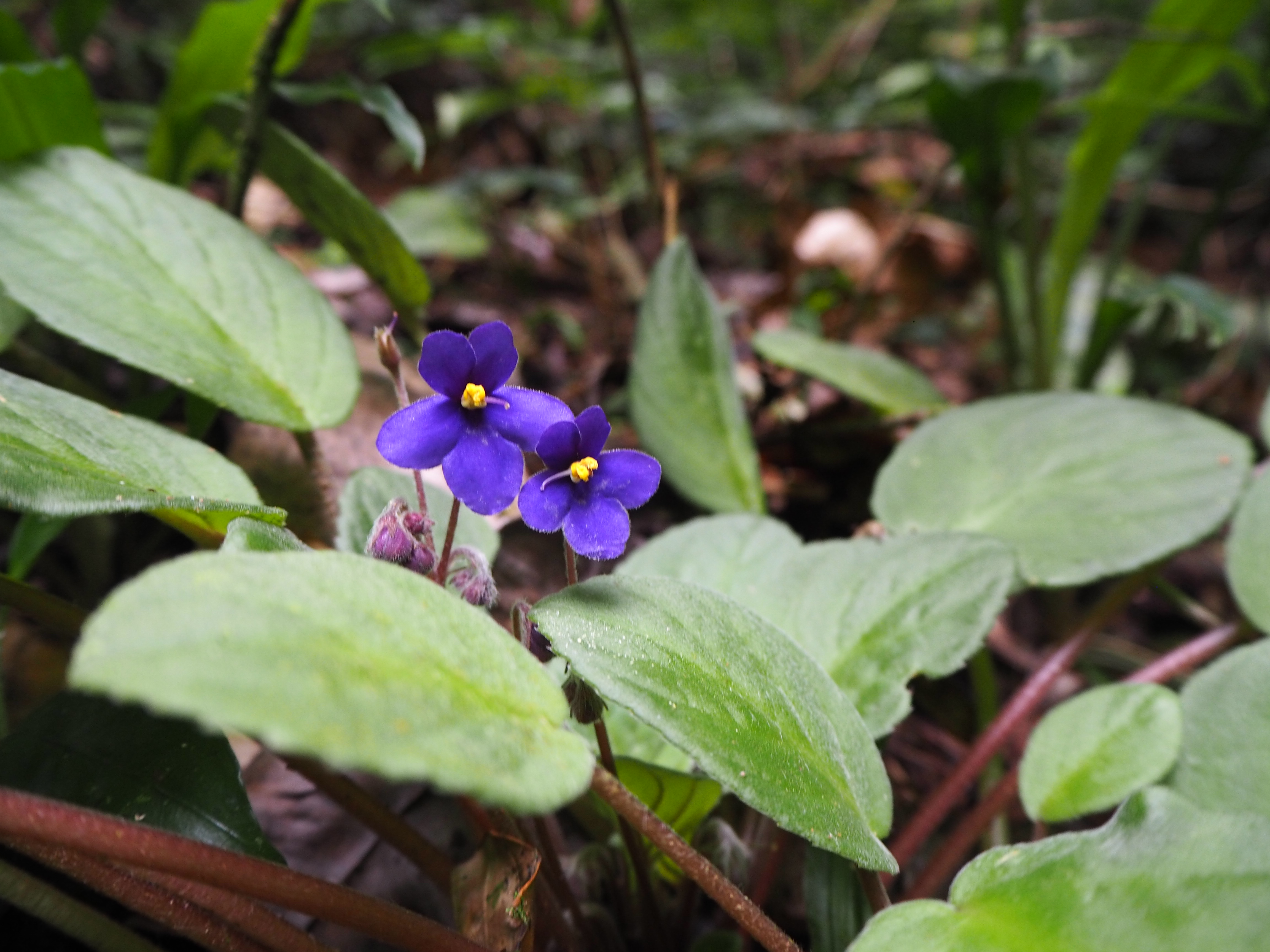
The African Violet (also known as Saintpaulia), is native to Amani forest and the surrounding areas.
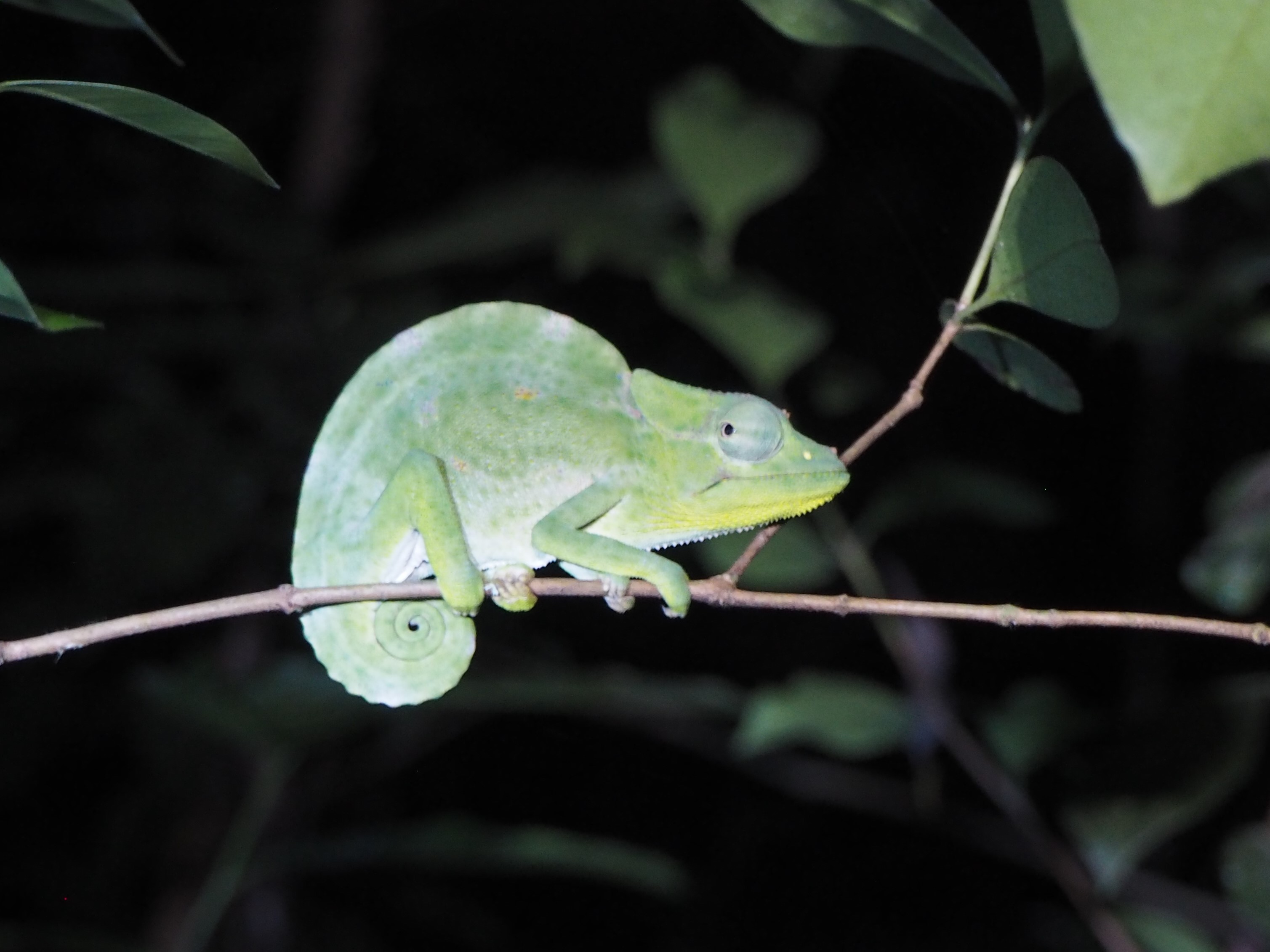
Chameleons can easily be spotted on a night walk in the forest, Amani Nature Forest Reserve, Muheza District.
Into the woods
The visit took the team into the woods, more specifically to Chome, Magamba and Amani nature forest reserves, all supported by UNDP through the Enhancing Nature Forest Reserves project (2014-2020). The purpose of the project is to enhance the protection of natural forests in Tanzania through establishing a network of Nature Forest Reserves, the category of protected areas that offers the highest level of protection under the National Forest Act of Tanzania. So far, 12 Nature Forest Reserves have been gazetted, many with support from the project.
An important contribution of the project is the construction of well-equipped ranger posts on the borders of the forests. A ranger post just outside Chome Nature Forest Reserve, which is located in a remote and mountainous area in Same District was recently constructed, greatly improving the rangers’ access to the forests. The proximity to the forest is a crucial factor in the rangers’ work including patrolling to prevent illegal logging and mining as well as the spread of wildfires.
Another significant contribution of the project is the construction and maintenance of walking trails and forest roads. These networks serve a dual purpose of servicing the forest officers on their daily patrols, while also making the forests more accessible to tourists, whether they prefer to discover the forest by foot, on a mountain bike or by car.

UNDP Country Director Natalie Boucly by a newly constructed ranger post, Chome Nature Forest Reserve, Same District.
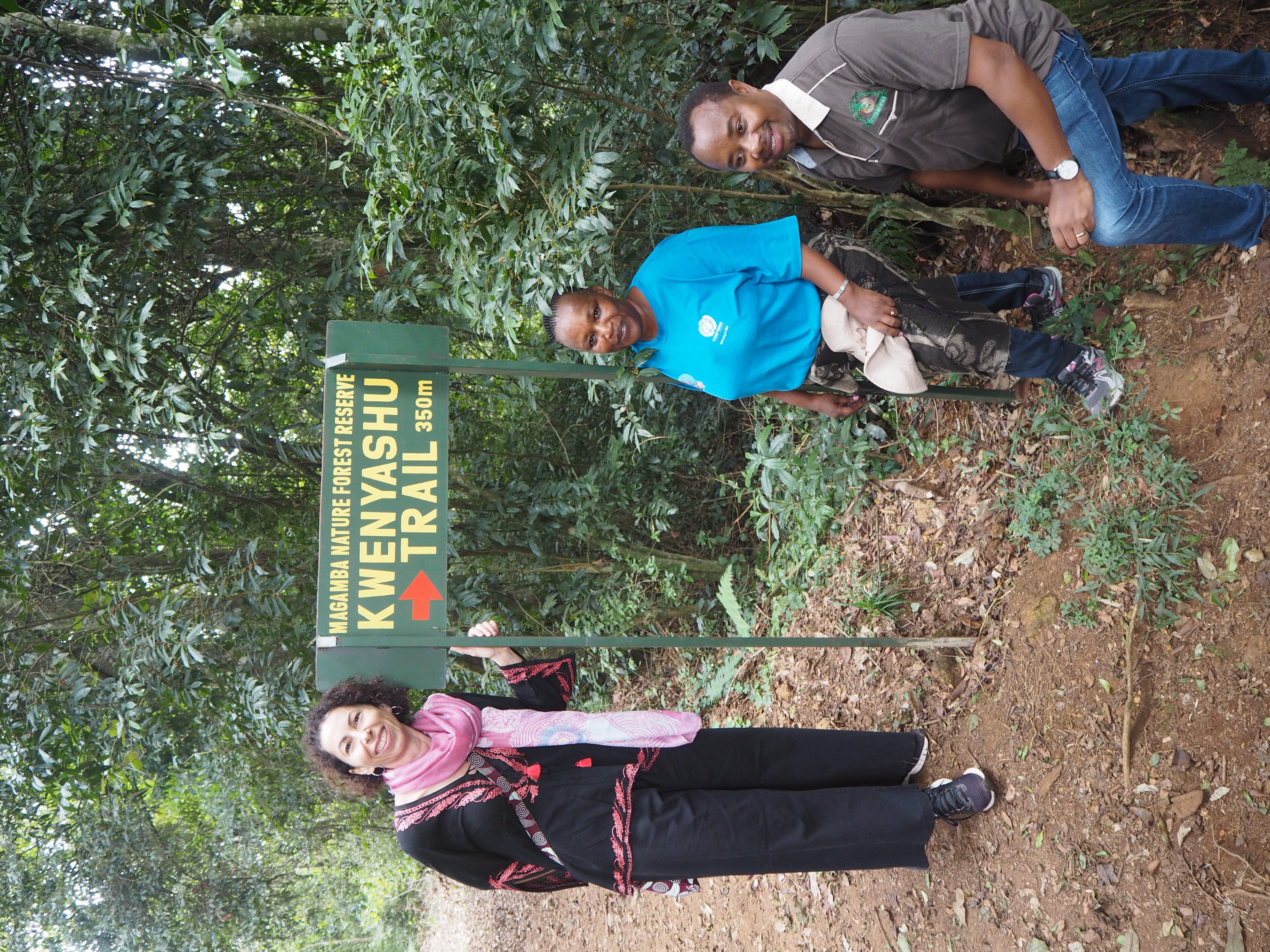
UNDP Country Director Natalie Boucly, UNDP Programme Specialist Gertrude Lyatuu and Tanzania Forest Service Agency Chief Executive Prof. Dos Santos Silayo on the Kwenyashu trail in Magamba Nature Forest Reserve, Lushoto District.
Cooking stoves, Biogas, and Butterflies
The communities living in and around the Nature Forest Reserves traditionally depend on the forest for fuelwood and other resources. To ensure sustainability, an important part of UNDPs work is to promote development opportunities for the communities, whilst reducing the pressures on the forest. Around Amani Nature Forest Reserve, the team visited two villages where such initiatives are supported. In Chemka village local artisans have been trained in building more fuel-efficient stoves. For Amina this means she now only collects fuelwood every other week, compared to twice a week before.
Another example is from Shebomeza Village, a village enclosed by the nature reserve, where UNDP has supported the construction of micro biogas plants. For Stella (below right), a widow who has been living all her life without electricity, manure from her cows provide enough gas for a stove and lamps for the household of 10 which she heads. Both these initiatives simultaneously reduce the need for fuel wood (and hence the pressure on the forests) and save both time and labour for the women using them.
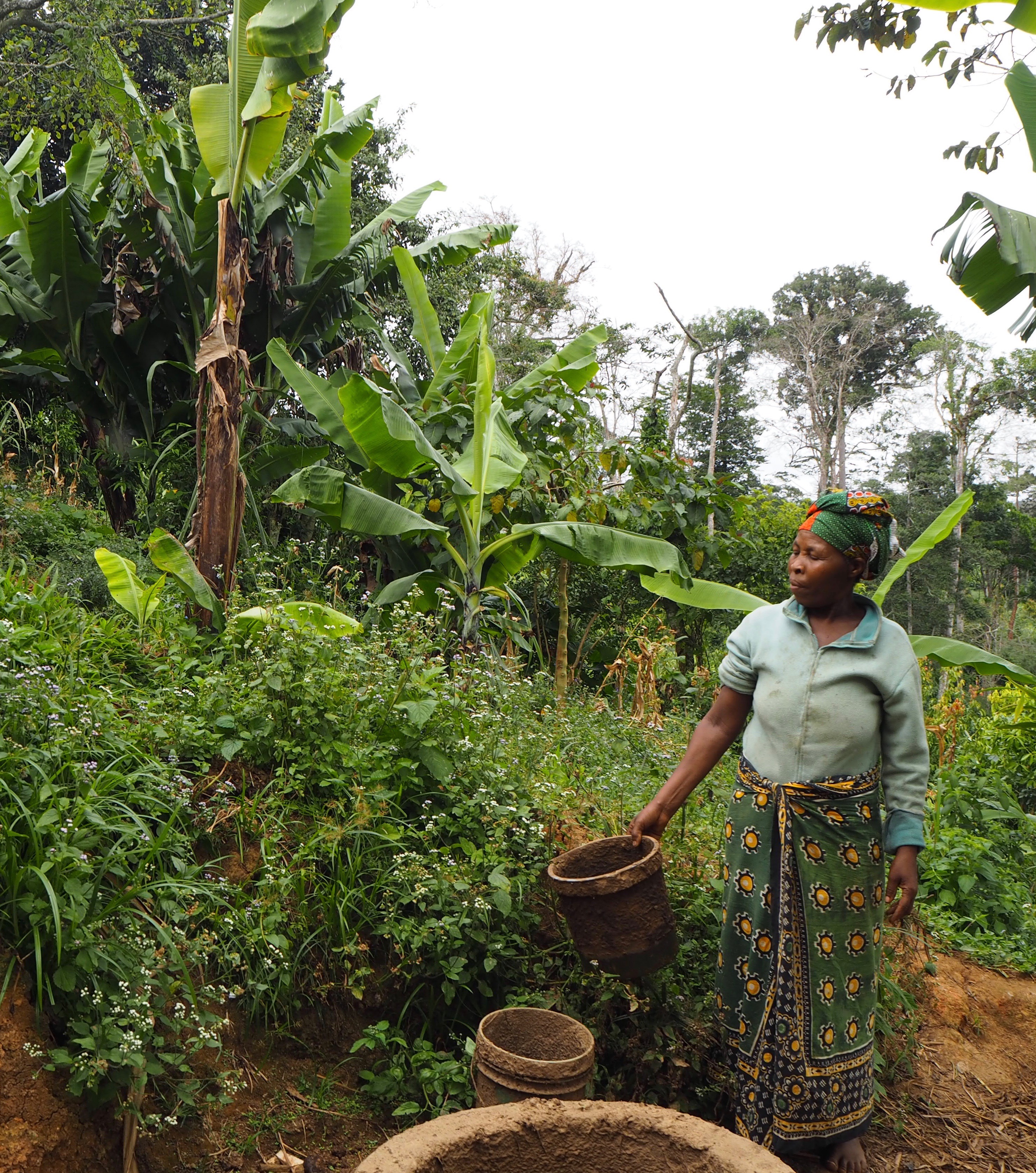
In Shebomeza Village Stella demonstrates how the household biogas plant transforms manure to gas and slurry.

In Chemka village, Muheza District, Amina has a new, more efficient cooking stove, built by local artisans
In addition to more efficient cooking technology, UNDP is committed to the creation of alternative, sustainable income generating activities for communities in and around the forests. In Fanusi village, outside Amani Nature Forest Reserve, one can visit a butterfly farm which was constructed with funds from the UNDP/GEF Small Grants Programme . The farmers collect a few pupae from the forest, which are bred inside a netted tent. The survival rate of the butterflies is much higher than in the wild, so they reproduce quickly. The pupae can be exported to fairs and exhibitions abroad, thus providing an alternative source of income for the communities. Furthermore, the butterflies attract tourists, which for a small entrance fee can admire the multitude of specimens up close. The Visitors Book, which the community proudly displayed, shows that not only tourists, but also the Minister of Natural Resources and Tourism along with many other dignitaries and Government officials recently visited the butterfly farm.
Irrigation furrows
In Hekapombe village, on the outskirts of Chome Forest Nature Reserve, the steepness of the surrounding terrain makes farming challenging due to loss of moisture and nutrients from the soil and the threat of erosion. Through the Small Grants Programme ¸ this is a challenge that has been overcome: the village has constructed irrigation furrows from a nearby stream originating in the forest, and the water is channelled to farming terraces. The terraces retain the moisture and nutrients, while trees planted along the ridges and edges of the terraces provide shade and prevent erosion.
Safeguarding the water – “Maji ni Uhai” (Water is life)
In addition to being the home of unique biodiversity in terms of plants, animals and insects, Tanzania’s forests also play an important role as water catchment areas. The rain that falls in the country’s forest flows into streams and rivers that eventually provide millions of people with water. That is also the case for the Zigi River, which rises from the Usambara Mountains, where Amani Nature Forest Reserve is located.
To enhance the sustainability of the river catchments, UNDP is not only supporting the protection of the upstream forest, but also downstream communities that rely on the river for irrigation and household needs. Through the Securing Watershed Services Project (2015-2020), UNDP, the Ministry of Water and Irrigation and Tanga Urban Water Supply and Sanitation Authority have supported the construction of permanent water supply to Mashewa village in Muheza District.
The project has improved both the daily life of the community and protects the environment. Before the water supply was in place, the community went to the river to gather water, wash clothes and water their cattle. This practice was risking contamination of the water source for hundreds of thousands of people downstream as well as erosion of the riverbank. Now, the community spends less time collecting water for their daily needs, whilst the riverbanks are used for growing crops such as black pepper, which in addition to hindering erosion provides an additional source of income for the community.

Women and children gathering water in Mashewa village, Muheza District.
A call for action
The latest report from the Intergovernmental Panel on Climate Change (IPCC) reaffirms what we already know: there is no Planet B. The UN Secretary General stated it clearly: “climate change is running faster than we are.”. The global changes will have local impacts, including on the forests and rivers of Tanzania, and the communities depending on them. The contributions described above may be small in a global perspective, but they are nonetheless critical to safeguard the environment and combat deforestation, whilst preserving the livelihoods of communities.
The week-long field trip provided plenty of first-hand impressions of how UNDPs support is making a real difference to the environment and to the local communities. The impacts of the initiatives are tangible and significant, and serve as good examples of activities that can be scaled up and implemented in other places as well. UNDP is committed to continue these efforts, in partnership with the Government of Tanzania and the international donor community.
Only by working together will we achieve our goal of sustainable development, for people and for the planet. If you are interested in partnering with us or simply want to know more about the sites mentioned in this article, contact Gertrude Lyatuu, Practice Specialist (Environment and Natural Resources) [email protected]
To read more about the projects mentioned in the article, download the project fact sheets here :
Related Content

#TakaBima: Elevating Waste Pickers Livelihoods through Micro-insurance
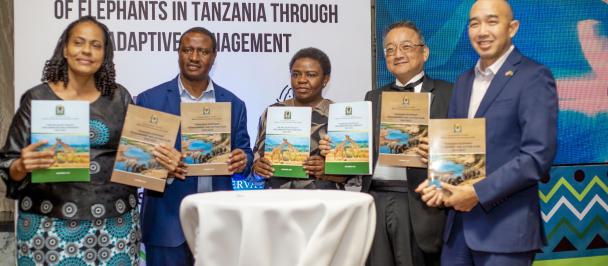
Press Releases
Wildlife policy implementation strategy and elephant management plan unveiled to combat poaching and illegal wildlife trade.
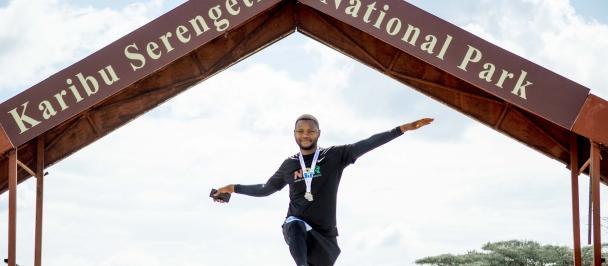
Serengeti Safari Marathon 2023: A Triumph of Conservation and Community Unity
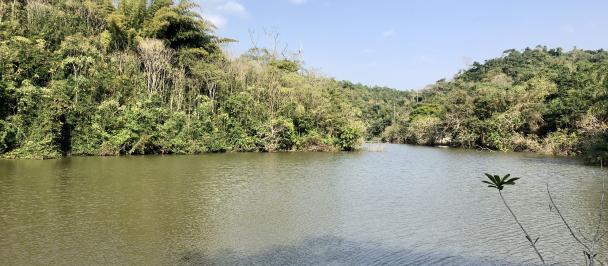
Climate Resilience in Action: Safeguarding Tanzania's Nature Forest Reserves

From Trash to Triumph: Tanga City's Waste Pickers Leading a Green Revolution

Publications
Advancing sustainable development in tanzania: undp's contribution 2019 - 2022.
Introducing the UNDP Tanzania Report for 2019-2022: A period of global challenges intertwined with a promising development trajectory for Tanzania. Discover the r...
8 Incredible Rainforest Destinations Around the World
- Metropolitan State University
Steve Daggar Photography / Getty Images
- Sustainable Fashion
- Art & Media
Dense rainforests filled with tropical plants and unusual creatures are usually associated with the vast Brazilian Amazon. But rainforest habitats can be found around the globe, and rainforest tourism comes in many forms. Some destinations are more like nature-oriented theme parks with zip lines and treetop bridges. Others are no more than dense jungle backwaters visited only by biologists and a few tourists in search of real adventure and truly untouched wilderness.
No matter what category they fit into, the best of these rainforest destinations have created a balance between championing conservation and building the infrastructure needed to support their eco-tourism industry. From the undeveloped interiors of Caribbean islands to the virgin jungles of southwestern Africa to the temperate rainforests of Oceania and the Pacific Northwest, it is possible to trek through a huge variety of rainforest landscapes.
Here are eight incredible rainforest destinations around the world.
Darién National Park (Panama)
Rchphoto / Getty Images
Panama's Darién National Park , a UNESCO World Heritage site, is one of the largest stretches of protected area in Central America. A vast land of dense jungle and low mountains, it contains hundreds of mammals and birds, including five endemic avian species and several unique mammal species that are not seen anywhere else on Earth. Lowland and highland rainforests dominate Darien, but it also includes rocky coastal areas and beaches.
Stretching along 90% of the border between Panama and Colombia, Darien is, undeniably, a very wild place. It is not a destination suitable for zip-line-riding and boardwalk-trekking eco-tourists. Nonetheless, guided tours, from daylong jaunts to multiday expeditions, are available through tour companies and led by local guides.
Dominica (Lesser Antilles)
Reinhard Dirscherl / Getty Images
The small island of Dominica is noticeably less developed than its tourism-happy Caribbean peers. That's a good thing for eco-tourists who flock to the island's low-key, Earth-friendly resorts to dive, visit sea turtle nesting areas, soak in hot springs, and trek across the undeveloped interior forests and highlands. Jungle trails, many leading to scenic sights like waterfalls or geothermal springs, crisscross the island's lowlands.
Dominica is built (or unbuilt) with eco-tourism in mind, so it is ideal for people who want to avoid the Caribbean beach scene altogether and focus on jungle and nature treks.
Martin Harvey / Getty Images
Gabon, a country in southwestern Africa, has nearly 83,000 square miles of tropical rainforests. Though commercial logging is a big industry in Gabon, efforts toward conservation and sustainability led to the creation of 13 national parks in 2002.
Loango National Park is the country's showcase attraction. This park was once dubbed the “Last Eden” because it contained some of the most pristine virgin forest remaining on the continent. The lands inside Loango host gorillas, forest elephants, water buffalos, and hundreds of other species of birds, reptiles, and mammals.
Manu National Park (Peru)
Kevin Schafer / Getty Images
Most of the Amazon rainforest sits in Brazil, but Manu National Park in Peru is home to more plants and animals than almost any other natural area on Earth. Hundreds of mammal species and 850 species of birds call these dense forests home, and thousands of unique types of plants have been cataloged inside Manu's borders. The forests are pristine, and the wildlife, including jaguars, giant otters, giant armadillos, and primates, thrive in this isolated and diverse ecosystem. A UNESCO World Heritage site, over 6,600 square miles of this vast, biodiverse region is protected.
Programs for eco-tourists—including guided tours (a must in this wilderness)—make Manu a remote yet accessible option for those who want to introduce themselves to the flora and fauna of the Amazon.
Danum Valley (Malaysia)
Anders Blomqvist / Getty Images
Located in a pristine area of lowland forest, Malaysian Borneo's Danum Valley is a protected conservation area. The Danum Valley also serves as a research site for scientists studying rainforests. A number of unusual plants and animals thrive in this vast depression of native forests. Carnivorous pitcher plants and gigantic rafflesia flowers give this valley a truly exotic, almost primeval, feel. Pygmy elephants, orangutans, and gibbons are among the endangered animals that thrive in the valley.
Eco-resorts offer guests a place to stay in between jungle treks, canopy tours, and river adventures in the valley.
Tasmania (Australia)
Czardases / Getty Images
Temperate rainforest constitutes 14% of all native vegetation on Tasmania, an island south of the Australian mainland. These forests receive a high amount of moisture but are, as their label suggests, much cooler than their tropical peers. The wet landscapes, mostly found on the western side of the island, are incredibly scenic. The leafy trees and climbing vegetation of the tropics are rare in Tasmania, but evergreen trees and landscapes teeming with smaller mammals mean that this is a very unusual rainforest environment. Over 3,800 square miles of Tasmanian Wilderness is classified as a UNESCO World Heritage area.
Tasmania is a sparsely populated place (with only 541,100 residents in 2020), so enjoying the forests in relative solitude is possible. Some parks that contain rainforest landscapes maintain their isolated appeal by allowing only a certain number of guests to be inside the park at any one time.
Frans Lemmens / Getty Images
Located in northern South America, the population centers of Suriname are concentrated along the coast, leaving the inland areas nearly uninhabited. The Central Suriname Nature Reserve, a UNESCO World Heritage site, comprises over 6,000 square miles of tropical forest. In addition to animals common in the region, such as jaguars, giant armadillos, giant river otters, primates, and sloths, the reserve is home to 400 bird species and 5,000 vascular plant species.
Suriname has made an effort to expand its eco-tourism offerings, and these areas, though remote in feel, are quite convenient to access. Travel companies offer tours into the backcountry of the northern Amazonian rainforests. These expeditions rely on basic jungle lodges or simple tents (or even hammocks) that give any Suriname trip the feel of an adventure-infused expedition into unknown lands.
Olympic National Park (Washington)
Naphat Photography / Getty Images
Located in the Pacific Northwest near Seattle, Olympic National Park features a vast temperate rainforest characterized by coniferous trees, fast-growing mosses, and ever-damp weather. With 12 to 14 feet of rainfall annually, rainforest covers the western regions of the park. In addition to lush trees and plants, the park is home to important wildlife, including river otters, black bears, bobcats, and mountain lions.
Easily accessible for U.S.-based rainforest-seekers, long looping trails make multiday treks possible, and the vast remoteness of the park's inner recesses provides a true rainforest adventure.
- 8 Incredible Places Where the Ocean Glows
- Top 8 Agritourism Destinations in the World
- 8 Amazing Scuba Diving Destinations in the U.S.
- 8 Magnificent Travertine Terraces Around the World
- What Is Community-Based Tourism? Definition and Popular Destinations
- What Is Overtourism and Why Is It Such a Big Problem?
- 8 Scenic Movies Where Nature Is the Star
- 8 of the Best Safari Destinations in the U.S.
- 8 Gorgeous Natural Swimming Spots Around the World
- What Is Sustainable Tourism and Why Is It Important?
- 8 Fairy Tale-Like Destinations You Can See in Real Life
- How to Make Travel More Sustainable
- 9 of the World's Most Unusual Cave Destinations
- 10 of the World's Most Spectacular Artificial Reefs
- What Is Experiential Tourism?
- 10 Beautiful Cities to Explore by Foot

The United Republic of Tanzania
Tanzania forest services (tfs) agency, ecotourism destinations, enjoy life in nature.

- You are here:
- Destinations

Amani Nature Forest Reserves
“Home of African Violent flowers (“Saintpaulia”)
Amani Nature Forest Reserve (ANFR) is located in Muheza and Korogwe Districts in Tanga Region. The Nature Reserve covers an area of 8,380 ha and it has tremendous ecological importance with the astonishing African violet flowers ( Saintpaulia ) which is believed to have a spiritual aspect (power of forgiveness) and cultural significance. According to Bird Life International, the area is ranked the 12 th world best bird watching sites and the UNESCO list the Reserve among the designated Man and Biosphere Reserve in the World.
Apart from the Saintpaulia flowers, the reserve is gifted with other varieties of tourist attractions ranging from endemic species of flora and fauna, unique biodiversity, natural attractions, historical and cultural attractions. Additionally, the reserve is famous for varieties of bird and butterfly species. Other attractions are: the three horned chameleons, amazing waterfalls (at Zigi, Chemka and Ndola) where visitors can swim after a trek through the forest, Sunset and sunrise viewpoints, a Botanical garden which is one of the oldest in Africa with more than 1000 plant species from all over the globe, Cultural attractions that include Traditions, Historical sites with remnants of steam engines used during the colonial era, Beautiful viewpoint of tea plantations and spice farms.
Ecotourism Activities
The rich endowment of nature-based tourist attractions, offers a wide range ecotourism activities including nature viewing, bird watching, night walking safaris, picnicking and camping, sun downers, mountain biking, swimming in the plunge pools of waterfalls, forest trekking (hiking), cultural activities (local dancing or watching, local massage and local brew testing) research and educational tour, excursion and photographing.
Accessibility
The reserve is accessible from 3 routes. First route is from Dar es Salaam city 330 kilometers, the second route is from Arusha city some 446 kilometers and the third route is from Tanga city some 74 kilometers. Coincidentally all three routes pass through Muheza town.
Other Tourist Attractions near ANFR
Amani is a nearby attraction to other destinations such as Sadaan National Park through Pangani old town, Amboni Caves and Tongoni Ruins in Tanga City, Nilo Forest Nature Reserves in its Eastern side, Magamba Nature Forest Reserve in Lushoto, Chome Nature Forest Reserves and Mkomazi National Park along the way to Arusha.
Supporting Facilities
Accommodation facilities available:
- Two rest houses and comfortable tented camps within the reserve
- Other facilities, which are found outside the reserve areas.

Hiking through Amani NFR mountain is very attractive activities, there are three trails…

Bird Watching
Amani Nature Forest Reserve is home to a wide range of endemic, rare and endangered bird…

Amani Nature Forest Reserve also provide the Bonfire were tourist/visitors can start fire…

Now days night walking is becoming very popular to most of the tourist, one can conduct a…

Photographic
Slopes of a Nature Reserve is a catchment forest with beautiful hydrological features,…
Tourism Destinations
- Airline Flying to Tanzania
- Mangroove/Lakes/Beaches
- Cultural & Heritage Sites
- Api Tourism Sites
- Forest Plantations
- Lakes and Beaches
- Forest Reserves
Youtube Videos

Natural Habitat Adventures
Conservation through exploration.
- Canada Polar Bear Tours
- Southern Africa Safaris
- East Africa Safaris
U.S. National Parks Tours
Alaska Adventures
Canada & the North
- Galapagos Cruises & Tours
- Mexico & Central America Adventures
South America Adventures
Asia & Pacific Adventures
Europe Adventures
- Antarctica & Arctic
Adventure Cruises
- Easter Island
- Falkland Islands
- French Polynesia
- High Arctic
- New Zealand
- South Africa
- South Georgia Island
- Svalbard/Spitsbergen
- United States
- African Safari Wildlife
- Birds & Butterflies
- Whales & Marine Wildlife
- Active Expeditions
African Safaris
- Climate Change Departures
- Cultural Immersions
- Easier Adventures
- Fall Foliage
Family Adventures
- Great Migrations
- Habitat Club Departures
- Hiking & Trekking Adventures
- Kayaking Adventures
New Adventures
- NHA's Most Popular Adventures
Photo Expeditions
- Private Custom Adventures
- Rain Forest Tours
- Sailing Adventures
- Snorkeling Adventures
- Wildflower Season
- Women-Only Departures
Nature News
Get your catalog of the world's greatest nature journeys, make it private, daily dose of nature.
Trips by Region
Polar Bear Tours
Meet the King of the Arctic roaming its wild tundra home on the edge of Hudson Bay in Churchill, Canada
Intimate wildlife adventures featuring uncrowded private reserves and remote luxury bush camps
Galapagos Tours
Meet unique and amiable wildlife up close on expertly guided small-group explorations in the Enchanted Isles
Get close to brown bears, explore Denali and see abundant marine life by private boat in Kenai Fjords & Prince William Sound
Look for wolves in Yellowstone, gape at the Grand Canyon, hike Glacier's alpine heights, watch the sunrise in Acadia...and more!
Watch whales, heli-hike in the Canadian Rockies, see icebergs calve in Greenland, witness the northern lights
Explore the wild side of Europe as we leave big cities behind to explore less-discovered natural wonders
Mexico & Central America Tours
Ecotourism adventures with gray whales, monarch butterflies, sea turtles, scarlet macaws & more!
From the Amazon to the Andes, from the Pantanal to Patagonia, explore this continent's amazing biodiversity
View endangered pandas, tigers, orangutans, pygmy elephants, rhinos, koalas & other wildlife
Antarctica & Arctic Journeys
Commune with penguins, puffins and polar bears in the most remote wilderness areas on the planet
Photography Expeditions
For avid photographers of all ability levels, with coaching from an expert naturalist–photographer guide
Small-ship expedition voyages to the ends of the earth: explore polar regions, Amazon, Alaska & beyond
Women's Adventures
Led by Nat Hab's top women Expedition Leaders, these departures have a special focus on the contributions of women in our destinations
Discover, explore and have fun in nature as you build lifelong memories across generations!
Check out our newest trip offerings and first-run adventures all around the world!
Your Nature & Adventure Travel Experts
Our innovative partnership with wwf.
Get Weekly Updates
Our weekly eNewsletter highlights new adventures, exclusive offers, webinars, nature news, travel ideas, photography tips and more.

View Our 2025/2026 Digital Catalog
Discover the World's Best
Nature Travel Experiences

Together, Natural Habitat Adventures and World Wildlife Fund have teamed up to arrange nearly a hundred nature travel experiences around the planet, while helping to protect the magnificent places we visit and their wild inhabitants.

Send Me Travel Emails

Our weekly eNewsletter highlights new adventures, exclusive offers, webinars, nature news, travel ideas, photography tips and more. Sign up today!
Look for a special welcome message in your inbox, arriving shortly! Be sure to add [email protected] to your email contacts so you don’t miss out on future emails.
Send Us a Message
Have a question or comment? Use the form to the right to get in touch with us.
We’ll be in touch soon with a response.
Refer a Friend
Earn rewards for referring your friends! We'd like to thank our loyal travelers for spreading the word. Share your friend's address so we can send a catalog, and if your friend takes a trip as a first-time Nat Hab traveler, you'll receive a $250 Nat Hab credit you can use toward a future trip or the purchase of Nat Hab gear. To refer a friend, just complete the form below or call us at 800-543-8917. It's that easy! See rules and fine print here.
We've received your friend's information.
View Our 2025/2026
Digital Catalog
Thanks for requesting access to our digital catalog. Click here to view it now. You’ll also receive it by email momentarily.

Questions? Call 800-543-8917
Have a question or comment? Click any of the buttons below to get in touch with us. Hours Mountain Time
- 8 am to 5 pm, Monday - Friday
- 8 am to 3 pm on Saturday
- Closed on Sunday
Winter is here! Check out the winter wonderlands at these 5 amazing winter destinations in Montana
- Travel Tips
How Can Tourism Positively Affect The Conservation Of Forests?
Published: December 13, 2023
Modified: December 28, 2023
by Carolyne Solano
- Sustainability
Introduction
Welcome to the enchanting world of forests and tourism! Forests are not only awe-inspiring natural wonders, but they also play a critical role in maintaining our planet’s biodiversity, regulating climate, providing clean air and water, and supporting countless livelihoods. However, they face significant threats from deforestation and degradation, which have far-reaching environmental and socio-economic consequences.
In recent years, there has been a growing recognition of the potential of tourism to contribute to the protection and conservation of forests. This form of tourism, known as forest-based or nature-based tourism, seeks to showcase the natural beauty and ecological importance of forests while also promoting their preservation and sustainable management. By immersing visitors in the wonders of nature, forest-based tourism fosters a deeper understanding and appreciation of forests, igniting a desire to protect them for future generations.
This article will delve into the positive impacts of tourism on forest conservation, exploring the economic, ecological, social, and cultural benefits that can be derived from this symbiotic relationship. We will also examine the challenges faced by tourism in minimizing its ecological footprint and maximizing its contribution to forest conservation, and explore potential solutions to overcome these challenges.
Through the lens of successful case studies, we will highlight inspiring examples of how tourism has played a pivotal role in safeguarding forests and promoting sustainable practices. From the pristine rainforests of Costa Rica to the majestic national parks of Africa, we will witness how responsible tourism can be a powerful force for positive change.
So, join us on this expedition as we unravel the unique connection between tourism and forest conservation. Together, we will explore the diverse benefits that sustainable tourism can bring to our precious forests, and discover how each of us can play a part in protecting these natural treasures.
Importance of Forest Conservation
Forests are vital ecosystems that provide a wide range of environmental, social, and economic benefits. Conserving forests is crucial for the health and well-being of both humans and the planet. Here are some of the key reasons why forest conservation is of utmost importance:
- Biodiversity: Forests are home to a staggering array of plant and animal species, many of which are found nowhere else on Earth. Forests contain more than 80% of the world’s terrestrial biodiversity, making them crucial for the preservation of ecosystems and the protection of endangered species.
- Climate Regulation: Forests are natural carbon sinks, absorbing large amounts of carbon dioxide from the atmosphere and storing it in their trees and soils. By mitigating climate change, forests help to stabilize global temperatures and prevent extreme weather events.
- Water Source: Forests act as natural water filters, capturing rainwater and replenishing underground aquifers. They help to regulate water cycles, ensuring a steady supply of freshwater for human consumption, agriculture, and wildlife habitats.
- Soil Conservation: Forests prevent soil erosion by providing a protective cover of leaves and roots that stabilize the ground. They also enhance soil fertility through the deposition of organic matter, improving agricultural productivity.
- Medicinal Resources: Forests are a vast pharmacy of natural medicines, with approximately 25% of modern drugs derived from plants found in the rainforest. By conserving forests, we preserve potential cures for diseases and protect traditional medicinal knowledge.
These are just a few examples of the critical functions that forests serve. However, despite their importance, forests are under constant threat from deforestation, illegal logging, and unsustainable land-use practices.
Fortunately, forest-based tourism has emerged as a valuable tool for raising awareness about the importance of forest conservation. By showcasing the remarkable beauty and ecological significance of forests, tourism can generate support for conservation efforts and incentivize sustainable land-use practices.
In the next sections, we will explore the multifaceted link between tourism and forest conservation, and the numerous benefits that can be derived from this mutually beneficial relationship.
Connection between Tourism and Forest Conservation
Tourism and forest conservation are interconnected in a profound way. When managed responsibly, tourism can serve as a catalyst for protecting and preserving forests. Here’s how tourism and forest conservation are linked:
- Education and Awareness: Tourism provides a platform for educating visitors about the importance of forests and the need for their conservation. By immersing tourists in the natural beauty of forests, they develop a firsthand experience of the wonders these ecosystems hold. This deep connection fosters a sense of awe and appreciation, motivating individuals to become advocates for forest conservation.
- Economic Incentives: Forest-based tourism generates economic value for local communities and governments. By creating jobs, promoting local entrepreneurship, and generating income through tourism-related activities such as guided tours, accommodations, and souvenir sales, forest-based tourism provides an economic incentive for communities to protect their forests. This economic benefit can help reduce the pressure for unsustainable exploitation, such as illegal logging or conversion to agricultural land.
- Community Engagement: Forest-based tourism often involves partnerships with local communities, empowering them to actively participate in conservation efforts. By involving community members as tour guides, nature interpreters, or in other tourism-related activities, they become important stakeholders in the preservation of their surrounding forests. This sense of ownership and pride encourages communities to actively safeguard their natural resources, ensuring their long-term sustainability.
- Sustainable Practices: To attract environmentally conscious visitors, forest-based tourism operators are increasingly adopting sustainable practices. This includes minimizing water and energy consumption, reducing waste, preserving natural habitats, and engaging in responsible wildlife viewing. These practices not only minimize the negative impact on forests and their ecosystems but also set an example for other industries to follow suit.
- Conservation Financing: Revenue generated from forest-based tourism can be reinvested into conservation initiatives. For example, entrance fees to national parks or protected areas can be used to fund the recruitment of additional park rangers, the implementation of anti-poaching measures, or the restoration of degraded habitats. This sustainable funding model ensures that forests continue to receive the necessary resources for their long-term preservation.
By harnessing the power of tourism, we can create a positive feedback loop where the conservation of forests leads to the growth of sustainable tourism, which in turn contributes to further conservation efforts. This interconnected relationship holds immense potential for both environmental and socio-economic benefits.
In the following sections, we will explore the specific economic, ecological, social, and cultural benefits that can be derived from forest-based tourism. We will also address the challenges faced by this form of tourism and discuss potential solutions for minimizing its impact on forests.
Economic Benefits of Forest-Based Tourism
Forest-based tourism brings significant economic benefits for both local communities and national economies. Here are some key ways in which tourism contributes to the economic well-being of forest regions:
- Job Creation: Forest-based tourism provides employment opportunities for local communities, particularly in rural and remote areas where alternative income sources may be limited. Jobs in tourism can range from tour guides and park rangers to hotel staff and artisans selling locally made crafts. These employment opportunities not only generate income but also help alleviate poverty and improve living standards in forest communities.
- Entrepreneurship Development: Tourism can stimulate entrepreneurship and small business development. Local residents have the opportunity to establish their own guesthouses, restaurants, tour companies, and craft shops, creating a vibrant entrepreneurial ecosystem. This empowers communities to take control of their economic destiny and reduce reliance on unsustainable activities such as logging or agriculture.
- Revenue Generation: Forest-based tourism generates revenue through visitor spending. This includes accommodations, meals, transportation, equipment rentals, and the purchase of local products and services. The revenue generated from tourism activities can be reinvested in local infrastructure development, conservation initiatives, healthcare, education, and other essential services that benefit both residents and visitors.
- Multiplier Effect: The economic impact of tourism goes beyond direct spending. Money spent by tourists circulates within the local economy, creating a multiplier effect. For example, when a visitor purchases a souvenir from a local artisan, that money is often reinvested in the community through the purchase of supplies or supporting other local businesses. This ripple effect helps stimulate economic growth in the area.
- Improved Infrastructure: To accommodate tourists, forest regions often require new or upgraded infrastructure such as roads, airports, accommodations, and recreational facilities. These infrastructure developments not only enhance the tourism experience but also improve transportation and accessibility for local communities. This allows for easier movement of goods and services, attracting investments and fostering economic diversification.
Forest-based tourism’s economic benefits can be particularly transformative in developing countries where forests are abundant, and opportunities for income generation are limited. By capitalizing on the natural beauty and biodiversity of their forests, these countries can attract visitors, boost local economies, and fund conservation efforts simultaneously.
It’s important to note that sustainable tourism practices are essential for maximizing these economic benefits. Local communities, governments, and tourism operators must work collaboratively to ensure that tourism activities are responsibly managed to minimize negative impacts on the environment and local cultures. Only through sustainable practices can forest-based tourism continue to thrive and provide long-term economic benefits.
In the following sections, we will explore the ecological, social, and cultural benefits that forest-based tourism can bring, further highlighting the value of this symbiotic relationship between tourism and forest conservation.
Ecological Benefits of Forest-Based Tourism
Forest-based tourism offers a range of ecological benefits that contribute to the preservation and sustainable management of forests. Here are some key ways in which tourism positively impacts forest ecosystems:
- Habitat Conservation: Forest-based tourism promotes the protection and conservation of natural habitats. When managed responsibly, tourism activities are designed to minimize disturbance to wildlife and their habitats. This helps preserve the delicate balance of ecosystems, ensuring the survival of diverse plant and animal species that rely on forests for their homes.
- Sustainable Land Use: Tourism provides economic incentives for sustainable land-use practices. In forest regions, where deforestation for agriculture or logging can be a common threat, tourism offers an alternative revenue stream that encourages communities to preserve their forests rather than exploit them unsustainably. This leads to better land management practices, reduced deforestation, and the preservation of forest ecosystem services.
- Education and Research: Forest-based tourism plays a crucial role in educating visitors about forest ecosystems and the importance of conservation. Engaging with knowledgeable tour guides and participating in interpretive programs allows tourists to learn about the unique flora and fauna, ecological processes, and conservation challenges of the forest. This knowledge fosters a sense of stewardship and inspires individuals to become advocates for forest conservation.
- Wildlife Conservation: The presence of tourists can provide a protective effect for wildlife populations. Tourism activities often require the presence of park rangers or guides, providing a deterrent against illegal hunting, poaching, or other illegal activities. Moreover, the economic value of wildlife-based tourism can create a direct financial incentive for communities to protect endangered species and their habitats.
- Restoration and Reforestation: Forest-based tourism can contribute to the restoration and reforestation of degraded areas. Tourism operators can engage in tree planting initiatives or collaborate with conservation organizations to restore deforested or degraded forest landscapes. These efforts not only help sequester carbon and combat climate change but also restore vital habitats for biodiversity.
By fostering a deep connection between visitors and forests, tourism inspires a sense of awe and appreciation for nature. This connection, in turn, motivates individuals to take action to protect the environment and make sustainable choices in their daily lives.
It is important to note that responsible tourism practices are vital for maximizing these ecological benefits. Tourism operators and visitors must adhere to guidelines and regulations that minimize the impact on forest ecosystems, such as respecting wildlife and their habitats, minimizing waste and pollution, and participating in sustainable activities that do not harm the environment.
In the next sections, we will explore the social and cultural benefits of forest-based tourism, illustrating how this form of tourism can contribute to local communities and the preservation of traditional cultures.

Social and Cultural Benefits of Forest-Based Tourism
Forest-based tourism not only brings ecological and economic benefits but also has profound social and cultural impacts on local communities. Here are some key ways in which tourism positively influences social and cultural aspects in forest regions:
- Preservation of Traditional Cultures: Forest-based tourism provides a platform for showcasing and preserving the rich cultural heritage of indigenous communities and local residents. Visitors have the opportunity to learn about traditional practices, rituals, and craftsmanship that have been passed down through generations. This cultural exchange fosters pride in one’s heritage and encourages the continuation of cultural traditions, helping to prevent cultural erosion.
- Empowerment and Community Development: Tourism can empower local communities by providing them with economic opportunities and a voice in decision-making. By actively participating in tourism activities, such as offering homestays, guiding nature walks, or showcasing traditional arts and crafts, communities can take control of their own development. This empowerment helps to build self-sufficiency, enhance social cohesion, and improve the overall quality of life for community members.
- Cross-Cultural Exchange: Forest-based tourism promotes cross-cultural understanding and appreciation. It allows visitors from different parts of the world to interact with local communities, sharing their own cultures while learning about the customs and traditions of the host communities. This exchange of ideas and beliefs fosters mutual respect, tolerance, and a broader perspective on global issues.
- Education and Skill Development: Tourism offers opportunities for education and skill development within local communities. As tourism grows, there is a demand for trained guides, hospitality staff, and other tourism-related professions. This creates avenues for local residents to acquire new skills, receive formal training, and improve their career prospects.
- Empathy and Conservation Mindset: Forest-based tourism helps foster empathy and a conservation mindset among visitors. By immersing themselves in the beauty of forests and engaging with local communities, tourists develop a deeper connection to nature and the challenges faced by forest regions. This empathy translates into support for conservation initiatives and a commitment to making sustainable choices in their own lives.
Forest-based tourism also plays a significant role in promoting social inclusivity and gender equality. Tourism can provide opportunities for women and marginalized groups, who may face limited options for income generation in traditional rural settings. By participating in tourism-related activities, these individuals gain economic independence and a stronger voice in decision-making processes.
However, it is important to ensure that tourism development is carried out in a culturally sensitive manner, respecting the local customs, traditions, and privacy of communities. Engaging with local communities in a fair and equitable manner, involving them in decision-making, and providing them with a fair share of the economic benefits are essential for fostering positive social and cultural impacts.
In the following sections, we will explore the challenges faced by forest-based tourism in minimizing its impact on forests and communities, and discuss potential solutions for sustainable tourism practices.
Challenges and Potential Solutions for Tourism’s Impact on Forests
While forest-based tourism offers numerous benefits, it is not without its challenges. Balancing the demands of tourism with the need to protect forest ecosystems and the well-being of local communities requires careful planning and implementation. Here are some key challenges and potential solutions for minimizing tourism’s impact on forests:
- Overcrowding and Habitat Degradation: Popular forest destinations can suffer from overcrowding, leading to habitat degradation and disturbance to wildlife. To mitigate this challenge, visitor management strategies can be implemented. These may include limiting the number of visitors, implementing permits or quotas, and establishing designated areas for tourism activities to minimize the impact on sensitive ecosystems.
- Infrastructure Development: The construction of tourism infrastructure can have negative environmental effects, such as deforestation, soil erosion, and disruption of wildlife habitats. Sustainable infrastructure development practices, such as using locally sourced materials, minimizing energy and water consumption, and incorporating renewable energy sources, can help reduce the ecological footprint of tourism operations.
- Resource Consumption and Waste Management: Tourism activities can put a strain on natural resources and generate waste. Implementing sustainable tourism practices, such as promoting energy and water conservation, encouraging waste reduction and recycling, and supporting local initiatives for waste management, can minimize the environmental impact of tourism and keep forests clean and pristine.
- Community Empowerment and Benefit Sharing: Ensuring that local communities benefit equitably from tourism is essential for minimizing negative social impacts. Empowering local communities through ownership or active participation in tourism enterprises, fostering dialogue and collaboration between communities and tourism operators, and establishing fair and transparent benefit-sharing mechanisms help ensure that the economic benefits of tourism are distributed fairly.
- Cultural Sensitivity and Respect: Tourism should be conducted in a culturally sensitive manner, respecting the customs, traditions, and privacy of local communities. This includes providing opportunities for communities to share their cultural heritage on their own terms, promoting informed cultural interactions, and engaging in dialogue to prevent cultural appropriation or exploitation.
- Capacity Building and Education: Providing training and educational opportunities for tourism stakeholders, including local communities, tour guides, and tourism operators, is crucial for ensuring sustainable tourism practices. Training programs can focus on environmental conservation, cultural sensitivity, responsible guiding practices, and the management of natural and cultural resources to enhance the long-term viability of forest-based tourism.
Addressing these challenges requires collaboration and partnership between government agencies, local communities, tourism operators, and conservation organizations. By implementing these potential solutions, we can develop a sustainable and responsible tourism industry that minimizes its impact on forests while maximizing the benefits for both the environment and local communities.
In the next section, we will explore inspiring case studies that exemplify successful examples of tourism supporting forest conservation, providing valuable insights and lessons learned from real-world experiences.
Case Studies: Successful Examples of Tourism Supporting Forest Conservation
There are numerous inspiring examples of how tourism has played a pivotal role in supporting forest conservation efforts around the world. These case studies demonstrate the positive impacts that responsible tourism can have on forests and local communities. Here are a few noteworthy examples:
Eco-Tourism in Costa Rica
Costa Rica is renowned for its commitment to sustainable tourism and forest conservation. With over 25% of the country’s landmass protected as national parks and reserves, Costa Rica has harnessed the power of eco-tourism to fund conservation efforts. Visitors flock to explore pristine rainforests, watch diverse wildlife, and engage in activities such as canopy tours, birdwatching, and guided hikes. The revenue generated from tourism is reinvested in conservation initiatives, including reforestation programs, wildlife monitoring, and community development projects. Through partnerships between the government, local communities, and tourism operators, Costa Rica has shown how sustainable tourism can be a driving force in protecting and preserving their natural treasures.
Gorilla Tourism in Rwanda
In Rwanda, the tourism industry centered around mountain gorilla conservation has been a game-changer. With only around 1,000 mountain gorillas remaining in the wild, tourism has become a crucial conservation tool. Visitors to Volcanoes National Park have the opportunity to trek through the dense forests and encounter these magnificent creatures in their natural habitat. The revenue generated from gorilla permits and associated tourism activities directly supports gorilla conservation efforts, providing funding for anti-poaching patrols, habitat protection, and local community development projects. This successful partnership between tourism and conservation has contributed to the increase in mountain gorilla populations and has become a model for sustainable wildlife tourism worldwide.
Community-Based Tourism in the Amazon, Brazil
In the Brazilian Amazon, several community-based tourism initiatives have emerged, empowering local communities to protect their forests while providing authentic and sustainable tourism experiences. Indigenous communities, such as the Kayapo and Yawanawa, have opened their lands to responsible tourism, offering visitors a chance to learn about their traditional customs, medicinal plant knowledge, and their deep connection to the forest. Through tourism, these communities have found an alternative income source that encourages the preservation of their ancestral lands and cultural heritage. Tourist revenues are often reinvested in community development projects, education programs, and forest conservation initiatives. This model of community-based tourism not only protects the Amazon but also preserves the cultural richness and wisdom of indigenous communities.
These case studies demonstrate that when tourism is managed responsibly and in partnership with local communities, it can serve as a powerful force for forest conservation. By generating revenue, raising awareness, empowering communities, and supporting sustainable practices, tourism has the potential to create a win-win situation for both the environment and the people who depend on forests for their livelihoods.
In the concluding section, we will summarize the key insights from this article and emphasize the importance of fostering sustainable forest-based tourism.
Forests are invaluable ecological treasures, providing essential ecosystem services and supporting countless species. However, they face numerous threats, making their preservation and sustainable management crucial for the well-being of our planet. Forest-based tourism has emerged as a powerful tool in the conservation of forests, offering economic, ecological, social, and cultural benefits. Throughout this article, we have explored the strong connection between tourism and forest conservation, highlighting the positive impacts that responsible tourism can bring.
From the economic perspective, forest-based tourism generates employment opportunities, stimulates entrepreneurship, and contributes to local economies. It also provides a sustainable funding source for conservation initiatives, ensuring the long-term protection of forests. On the ecological front, tourism promotes habitat conservation, sustainable land-use practices, and the restoration of degraded areas. It also raises awareness about the importance of forests and fosters a conservation mindset among visitors.
Forest-based tourism also brings significant social and cultural benefits. It empowers local communities, preserves traditional cultures, promotes cross-cultural understanding, and provides education and skill development opportunities. By creating avenues for community involvement, tourism encourages social inclusivity and gender equality.
While forest-based tourism offers great potential, it is not without challenges. Maintaining a balance between tourism activities and the preservation of forests requires careful planning, responsible practices, and inclusive decision-making. Managing issues such as overcrowding, infrastructure development, resource consumption, and community empowerment are essential for long-term sustainability.
The case studies we explored, from Costa Rica’s eco-tourism success to Rwanda’s gorilla tourism model and community-based initiatives in the Amazon, exemplify how tourism can be a driving force for forest conservation. By learning from these examples and implementing sustainable tourism practices, we can create a future where forests thrive, local communities prosper, and visitors experience the profound beauty and importance of these invaluable ecosystems.
In conclusion, forest-based tourism holds immense potential to foster a deeper connection between humans and nature while serving as a driving force for the conservation of our planet’s precious forests. By embracing sustainable practices, supporting local communities, and engaging in responsible tourism, each of us can contribute to the preservation of forests and ensure that future generations can continue to experience the wonders and benefits they offer.

- Privacy Overview
- Strictly Necessary Cookies
This website uses cookies so that we can provide you with the best user experience possible. Cookie information is stored in your browser and performs functions such as recognising you when you return to our website and helping our team to understand which sections of the website you find most interesting and useful.
Strictly Necessary Cookie should be enabled at all times so that we can save your preferences for cookie settings.
If you disable this cookie, we will not be able to save your preferences. This means that every time you visit this website you will need to enable or disable cookies again.

How Tourism Benefits Nature and Wildlife
The Great Barrier Reef. Yellowstone. The Amazon Rainforest. One of the top reasons that tourists are drawn to destinations such as these is because of their rich biodiversity and unique landscapes.
According to Brand USA, 2 of the top 5 motivators for selecting vacation spots are ecotourism and nature. Wanderlusters are seeking experiences that reflect the true essence of the places they are visiting. In other words, they want to visit places with unspoiled environments and thriving native wildlife.
We often hear about all of the ways that humans are destroying wild places and jeopardizing the health of the planet – and rightfully so. Over 75% of land environments have been severely altered by humans and species are facing extinction at up to 1000x the natural rate. While there’s no denying that irresponsible tourism contributes to this devastation, we shouldn’t overlook the important role that sustainable and well-managed tourism plays in advancing conservation and protecting our world’s treasured ecosystems. These benefits have only been further evidenced by the current COVID-19 crisis and the resulting halt in tourism.
In this blog post we’ve highlighted just a handful of the different ways that tourism benefits nature and wildlife. Read on to learn more!
Increasing Community Support for Conservation
Over the last decade, nature-based tourism has become increasingly popular. In total, wildlife tourism now supports nearly 22 million jobs around the world and contributes more than $120 billion to global GDP.
This growing interest in wildlife tourism, and the economic benefits that come along with it, can change community attitudes towards conservation. Without tourism, local communities may merely view wild animals as a danger to their farms and families, and only value natural resources for consumption. But when animals and natural areas bring tourism dollars and jobs to their community, it can help residents see the importance of keeping their natural assets intact and healthy.
In Cambodia, for instance, ecotourism is motivating communities to conserve critically endangered bird species, such as the giant ibis and white-shouldered ibis. Thousands of tourists come from across the world to see these rare and iconic species. The birding operator Sam Veasna Conservation Tours incentivizes community-based conservation in the region by training and employing locals as guides and ecotourism providers, and requiring visitors to donate to village development projects. In return for this income and employment, community members agree to not hunt or cut down trees. To date, Sam Veasna’s visitors have contributed over $500,000 to local communities, making a strong case for the importance of protecting their unique birdlife.
Creating Sustainable Livelihoods
Beyond changing mindsets, tourism can prevent ecosystem degradation by creating more sustainable livelihoods for local communities. Jobs as guides, cooks, or housekeepers offer alternative income sources to environmentally-destructive activities such as logging, slash-and-burn agriculture, quarrying, or illegal hunting.
In Rewa, Guyana, poor job security led villagers to illegally harvest and trade wild animals. As a result, wildlife species such as arapaimas, giant river turtles, and giant otters were beginning to disappear. In 2005, the village opened a community-run eco lodge to improve livelihoods while protecting its ecological diversity. By employing community members as sport fishing guides and boat captains, the lodge allows villagers to maintain rainforest-based livelihoods without causing damage to the ecosystem. Thanks to tourism, arapaimas, turtles, and otters are now common in the Rewa River. Not to mention, visitors contribute far more money to the local economy than wildlife exploitation did. In fact, research shows that globally wildlife tourism is 5x more lucrative than illegal wildlife trade!
Raising Environmental Awareness of Tourists
Tourism not only bears the capacity to shift local mindsets and behavior, it can also raise environmental awareness among tourists. From camping to beach lounging, tourism provides countless opportunities for individuals to learn about the natural world and experience it firsthand.
When people connect with nature during their travels, it can lead them to appreciate it more and become invested in protecting it. Tours, parks, and other travel experiences often facilitate this type of environmental learning through interpretive techniques such as educational brochures, exhibits, or guided excursions. Whale watching, for instance, has been shown to raise visitors’ knowledge of aquatic mammals and increase their support for whale conservation. And on the Great Barrier Reef, guided boat tours and marine biology talks have been found to influence visitor behavior and minimize the damage that they cause to the reef.
In Chilean Patagonia, interpretive panels have been installed along one of the world’s most iconic trekking circuits in Torres del Paine National Park. The panels, which were designed by the Torres del Paine Legacy Fund , educate visitors about the wetland ecosystem they’re traversing, and provide information about the plants and animals found there.
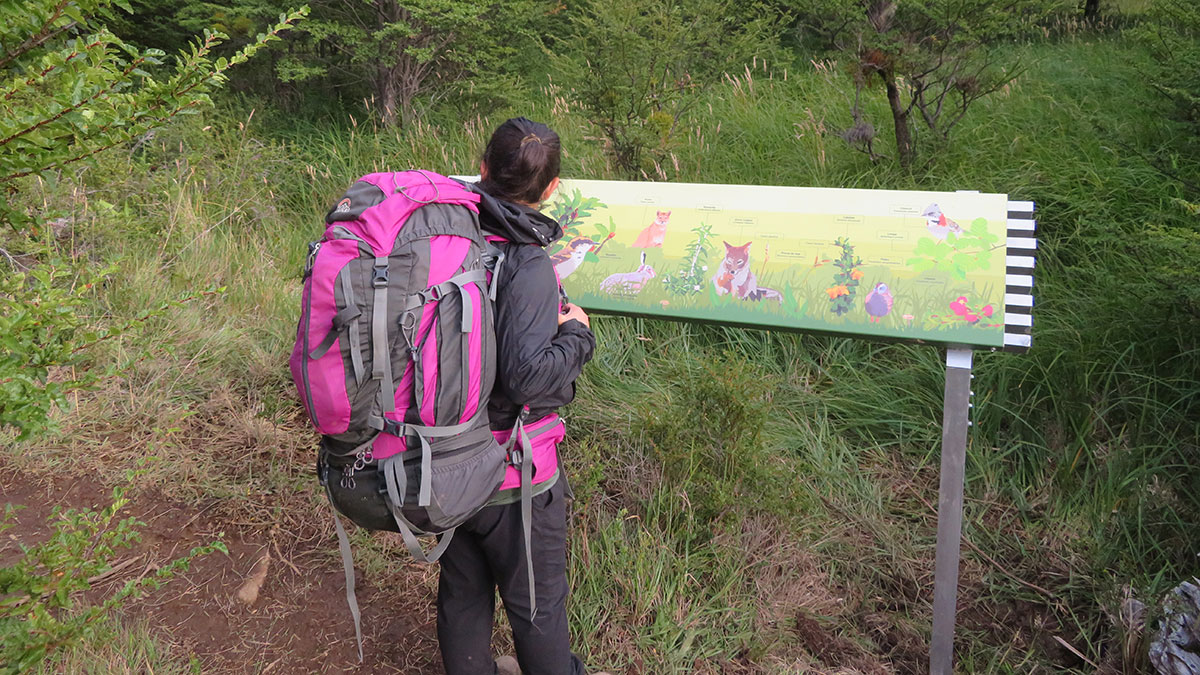
A hiker reads about the types of wildlife that reside in Torres del Paine National Park. Photo: Torres del Paine Legacy Fund.
Prompting Conservation Policies & Protected Areas
Tourism can also provide a compelling incentive for governments and organizations to institute environmental policies and conservation measures. This includes the creation of national parks, nature reserves, and other protected areas to preserve their biodiversity and correspondingly boost their tourism appeal.
Due to the popularity of coastal tourism in particular, reef-based activities such as scuba diving, snorkeling, boat trips and whale watching are a particularly important source of economic revenues. In fact, it is estimated that coral reefs generate $36 billion in global tourism value per year. Many countries rely on the income that comes from marine-based tourism and see the importance of protecting their coastlines, coral reefs, and beaches.
In the Galapagos, for instance, marine-based tourism is worth over $178 million per year, and supports over a third of all jobs. The islands are a hotspot for large and rare marine life, including the highest abundance of sharks on the planet. Thanks to spending by divers and other marine tourists, a single shark in the Galapagos is worth about $5.4 million over its lifetime, while a dead shark only brings in $200 to fishermen. Realizing the economic importance of its life below water, the government introduced no-fishing zones in 2016 to prevent the extraction of sharks and safeguard the island’s marine tourism value.
Mountain gorillas are another species that has benefited from tourism-motivated conservation policies. These endangered apes can only be found in Uganda, Rwanda, and the Democratic Republic of the Congo. In Uganda, gorilla trekking permits start at $600 and the economic value of gorilla tourism is estimated to be as much as $34.3 million . This has led to policies and strategies that support conservation, such as veterinary interventions, intensive law enforcement, community conservation projects, regulated ecotourism, and transboundary collaboration among government institutions and NGOs. Thanks to these efforts, the number of gorillas within the Virunga Mountain region rose from 240 in the 1980s to 604 in 2016 . Now they are the only wild ape population whose numbers are increasing !
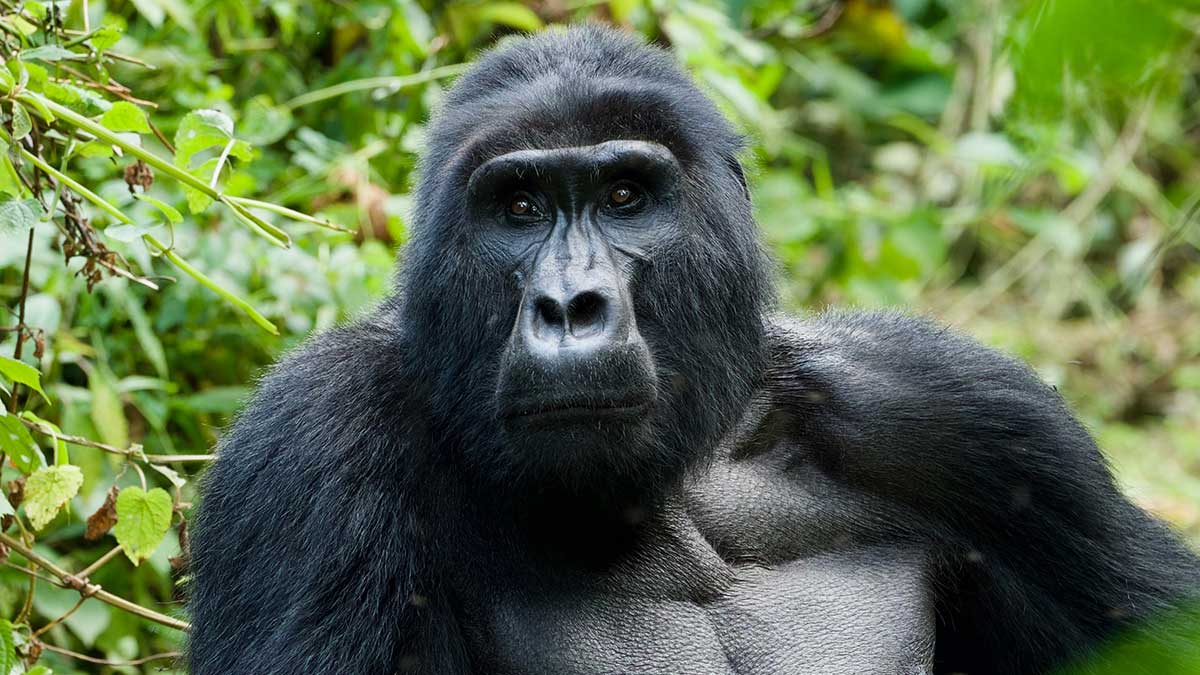
Financing Conservation
But simply establishing protected areas isn’t enough on its own. Ensuring the conservation of the sensitive environments and vulnerable species that these areas aim to protect requires effective management and conservation measures.
However, this is easier said than done. Around the world, many protected areas are under-funded. In fact, the global funding gap for effectively managing these sites is estimated to be up to $440 billion dollars per year. Tourism plays an essential role in bridging this gap by providing an additional source of funding. Proceeds from visitor entrance fees, operating permits, accommodations, and guiding services can help pay the salaries of park rangers and guards, and fund necessary management activities such as ecosystem monitoring, anti-poaching patrols, invasive species eradication, and environmental educational programs.
In Africa, tourism is an important source of funding for land and wildlife conservation. SANParks, the public entity responsible for managing South Africa’s national parks, raises more than 80% of its funding from tourism. Chumbe Island Coral Park, a marine protected area off the coast of Zanzibar, takes this model a step further and is funded entirely by ecotourism income. Thanks to effective management, Chumbe Island is home to one of the most pristine coral reefs in the region.
In addition to financing protected areas, tourists and tourism businesses may also contribute directly to local conservation initiatives. In St. Kitts, local tourism businesses donated $18,500 to fund the planting of fruit trees to protect coastal areas. At Vail Resorts, guests are invited to donate $1 when they purchase a season pass, lift ticket, hotel stay, or shuttle ride. In 2019, Vail’s program raised over $975,000 for on-the-ground conservation efforts that help restore habitat, improve forest access, and preserve land.

Carbon offsetting is another way that individuals and businesses can contribute to environmental conservation projects, while also mitigating their own emissions. Luxury tour operator TCS World Travel, for instance, partners with Sustainable Travel International to offset the carbon emissions generated by their jet trips. Through this partnership, TCS supports the Madre de Dios project which protects critical rainforest habitat and endangered species in the Peruvian Amazon.
Aiding Ecosystem Monitoring
While park rangers and guards play a critical role in patrolling sensitive environments, tracking ecosystem health, and warding off threats, it is often impossible for them to monitor such vast areas by themselves. The mere presence of tourists in natural areas can protect wildlife by providing an extra set of eyes on the ground.
In Africa, safari vehicles and guests deter poachers from wildlife conservancies, helping to safeguard highly targeted species such rhinos. The COVID-19 pandemic has further highlighted the critical role that tourism plays in deterring poachers and creating safe havens for wildlife. As visitation has come to a halt, rhino poaching has reportedly increased in tourism hotspots.
The Great Barrier Reef Marine Park Authority’s “Eye on the Reef” program is an even more intentional effort to engage tourists and operators in ecosystem monitoring. The program engages divers and marine tourism providers in watching over the Great Barrier Reef by reporting the coral, fish, pollution, and invasive species they see via a citizen science app. Sustainable Travel International is currently developing NEMO, a similar reef monitoring program for use on the Mesoamerican Reef.
There are countless other citizen science programs that aim to fill different research gaps, and that visitors can participate in during their trip. Whale watchers, for example, can contribute to whale identification and tracking by submitting their photographs of humpback whales via the HappyWhale website. To date, more than 260,000 photos have been submitted to HappyWhale, and more than 38,000 individual whales identified.
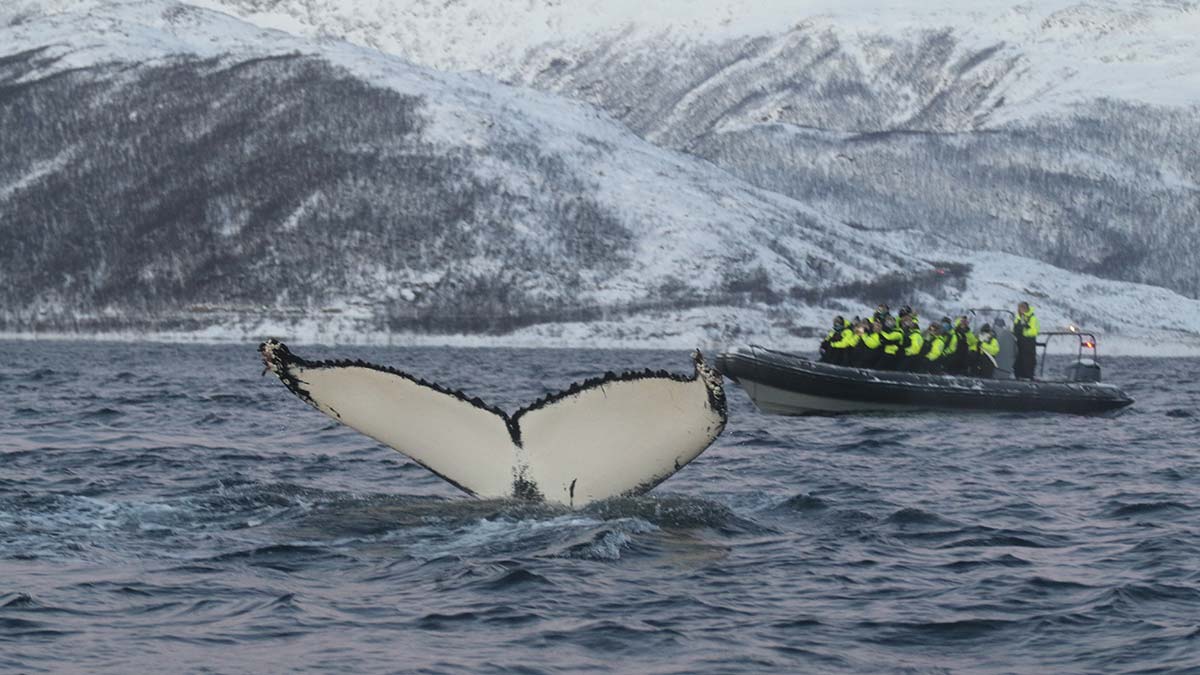
Tourism businesses may also aid researchers in collecting environmental data. In Nevis, the Four Seasons Resort helps researchers study the migration patterns of critically endangered hawksbill sea turtles that nest on the island’s beaches. Resort guests help look for nesting sea turtles which are then fitted with a satellite transmitter and released into the sea. To date, 21 turtles have been released through this program.
Supporting Habitat & Ecosystem Restoration
Along with putting on their scientist cap, visitors and tourism businesses can support conservation by participating in ecosystem restoration.
In Bonaire, local dive operators are lending a hand in restoring the island’s coral reefs by training tourists and divers on basic reef restoration techniques. Once they are trained, visitors can help maintain coral nurseries and outplant coral fragments onto degraded reef sites. To date, more than over 22,000 corals have been outplanted onto Bonaire’s reefs.
Visitors and tourism businesses can also participate in the removal and eradication of non-native species which devastate local habitats. In Mexico, divers and guides lend a hand in hunting invasive lionfish which are a serious threat to the Mesoamerican Reef. After they are captured, the fish are grilled up and served to tourists as a special local dish.

Visitors and tour guides can also help restore ecosystem health by cleaning up the environments they visit. For example, more than 86,000 scuba divers have removed litter from the oceans as part of Project Aware’s “Dive Against Debris” program.
Advancing Green Technologies & Fueling Innovation
Because of its economic importance and influence, tourism can trigger environmental innovation through the advancement of green infrastructure, processes, and technologies. For instance, tourism can lead the way in the development of renewable energy infrastructure, like wind and solar farms, on remote islands or rural areas that would not usually be exposed to clean energy.
In Aruba, tourism is the primary economic activity, representing 73% of GDP. Realizing that the future of its tourism industry depends on environmental sustainability, Aruba’s public and private sector have invested in innovative solutions. Aruba’s Bucuti & Tara Beach Resort, for instance, is considered an eco-pioneer in the Caribbean due to the novel sustainability initiatives that it not only implements, but also develops. Among its achievements, the property heats its water via solar panels, installed exercise equipment that produces electricity, utilizes water saving devices in its bathrooms, and reuses greywater to irrigate its gardens. The resort aids the sustainability transition on the island by offering tours of their grounds and sharing their practices with others.

In Oregon, tourism supported the expansion of electric vehicle infrastructure along the state’s rural roads and scenic highways. The state’s tourism commission, Travel Oregon , helped facilitate the installation of electric vehicle charging stations near tourism businesses and developed Electric Byway itineraries. Now, Oregon is home to one of the largest networks of electric vehicle fast charging stations in the country!
Still Progress To Be Made
But of course, all of the benefits above will only occur when tourism happens in a well-managed and sustainable way. As we’ve gained a better understanding of how humans impact the natural world, there have definitely been great strides towards making tourism more eco-friendly. However, our work is far from done. There’s still a lot of room for improvement by everyone involved in tourism – businesses, governments, communities, and tourists – to maximize tourism’s benefits for the planet.
To learn more about how we are helping to amplify the environmental benefits of tourism and ensure that tourism safeguards local ecosystems through our work, click here .
Free Sustainable Travel Tips List
- June 26, 2020
- Blog , Nature & Wildlife
Recent Posts
Spreading the love: how travel companies can disperse visitors to combat overtourism, climate impact update – 2024 portfolio 4, what is overtourism and why is it a problem, indigenous bunong women weave a brighter future, bird nest guardians in keo seima, reforesting keo seima wildlife sanctuary.
- August 2024
- January 2024
- December 2023
- November 2023
- October 2023
- September 2023
- August 2023
- January 2023
- November 2022
- October 2022
- September 2022
- February 2022
- January 2022
- December 2021
- October 2021
- September 2021
- January 2021
- December 2020
- November 2020
- October 2020
- August 2020
- February 2020
- January 2020
- December 2019
- November 2019
- October 2019
- September 2019
- August 2019
- October 2018
- September 2018
- February 2018
- December 2017
- November 2017
- October 2017
- September 2017
- August 2017
- February 2017
- October 2016
- September 2016
- February 2016
- November 2015
- October 2015
- September 2015
- August 2015
- September 2014
- © 2024 | Sustainable Travel International
- Privacy Policy
Download Our Sustainable Travel Tips List
Subscribe to get your free tips list, plus sustainable travel emails and content
Check your inbox for our Sustainable Travel Tips.
Forest tourism
- Living reference work entry
- Later version available View entry history
- First Online: 01 January 2015
- Cite this living reference work entry

- Daniel L. Erkkila 3
90 Accesses
Forest tourism is broadly applied to describe a variety of uses of forested landscapes as distinct attractions or environments. It has evolved to encompass product concepts like ecotourism , nature-based tourism, and outdoor recreation . Its unifying element is the recreational use of a forest environment .
With trees as the principal attribute, the world’s forest biomes range from boreal (taiga) forests in the northern latitudes to temperate deciduous forests in midlatitudes and to tropical rainforests in equatorial regions and southern latitudes. These endowed forests attract millions of tourists and recreationists with varied interests. Early attention focused on outdoor recreation within forests and social science research was descriptive, characterizing topics like site use, visitor behavior, crowding, and implications of negative impacts.
Geographically, the use and attraction of European and US boreal and deciduous forest areas received early attention. Eventually, interest in...
This is a preview of subscription content, log in via an institution to check access.
Access this chapter
Institutional subscriptions
Ceballos-Lascurain, H. 1996 Tourism, Ecotourism, and Protected Areas: The State of Nature-based Tourism around the World and Guidelines for its Development. Gland: IUCN.
Google Scholar
Font, X., and J. Tribe, eds. 2000 Forest Tourism and Recreation: Case Studies in Environmental Management. New York: CABI.
Gossling, S., and T. Hickler 2006 Tourism and Forest Ecosystems. In Tourism and Global Environmental Change: Ecological, Social, Economic and Political Interrelationships, S. Gossling and M. Hall, eds., pp. 95-106. New York: Routledge.
Download references
Author information
Authors and affiliations.
College of Food, Agricultural and Natural Resource Sciences, University of Minnesota, 1861 E Hwy 169, Grand Rapids, 55744, USA
Daniel L. Erkkila
You can also search for this author in PubMed Google Scholar
Corresponding author
Correspondence to Daniel L. Erkkila .
Editor information
Editors and affiliations.
School of Hospitality Leadership, University of Wisconsin-Stout, Menomonie, Wisconsin, USA
Jafar Jafari
School of Hotel and Tourism Management, The Hong Kong Polytechnic University, Hong Kong, Hong Kong
Honggen Xiao
Rights and permissions
Reprints and permissions
Copyright information
© 2014 Springer International Publishing Switzerland
About this entry
Cite this entry.
Erkkila, D.L. (2014). Forest tourism. In: Jafari, J., Xiao, H. (eds) Encyclopedia of Tourism. Springer, Cham. https://doi.org/10.1007/978-3-319-01669-6_363-1
Download citation
DOI : https://doi.org/10.1007/978-3-319-01669-6_363-1
Received : 25 June 2014
Accepted : 25 June 2014
Published : 15 September 2015
Publisher Name : Springer, Cham
Online ISBN : 978-3-319-01669-6
eBook Packages : Springer Reference Business and Management Reference Module Humanities and Social Sciences Reference Module Business, Economics and Social Sciences
- Publish with us
Policies and ethics
Chapter history
DOI: https://doi.org/10.1007/978-3-319-01669-6_363-2
DOI: https://doi.org/10.1007/978-3-319-01669-6_363-1
- Find a journal
- Track your research
Great Hiking
Welcome to shawneeforest.com.
Embark on exhilarating solo and family escapades in the Shawnee National Forest! Picture a world where even mud and rocks add an unexpected twist to the adventure. Believe it or not, it happens here! Forget crowded amusement parks or dull museums; enter the National Park in Illinois, where kids revel in outdoor attractions while adults delve into American and pre-America history, untouched nature, and breathtaking views. It’s not just about family picnics; try rock climbing, indulge in top-notch fishing, or experience kayaking and canoeing. Ever dream of staying in a log cabin or sleeping in a real treehouse? Your chance is here; come explore a bit!
Most Popular Hiking Trails in Shawnee Forest
Explore any of these beautiful and majestic hikes in the shawnee national park in illinois for incredible views and getting up close and personal with rock formations and indigenous history or enjoying family-oriented adventures with beautiful waterfalls, natural land bridges, and so much more., eastern shawnee, central shawnee.
Come and walk over or under the only natural land bridge found in Shawnee National Park in Illinois!
Cabins and Lodging in the Shawnee Forest
Cabins camping & hotels near the shawnee forest, bigfoot @ shawnee forest, vineyards and wine here, shawnee national forest maps.
GPS Map of the Shawnee (PDF/730k) This map has GPS coordinates for many of the major attractions within the Shawnee National Forest. It is highly recommended for all tourist to the southern Illinois area.
Pre-Vacation Planning Map (PDF/1024K) Interactive map listing many of the more popular attractions within the forest and linking to more detail. This map is great to use during the planning phase of vacation or hike to the Southern Illinois area or the Shawnee National Park in Illinois.

Latest From Our Blog

Guided Hiking Tours in Shawnee National Forest: What to Expect
Aug 19, 2024 | Hiking
Exploring the Shawnee National Forest in Southern Illinois is a great dream for outdoor lovers. Known for its diverse landscapes, many animals, and beautiful nature, this area has some of the best hiking trails in Illinois. One of the best and easiest ways to...

Exploring the Little Grand Canyon Walking Trail
Aug 6, 2024 | Little Grand Canyon
Little Grand Canyon in Shawnee National Forest is one of the most loved places to go on a hike in Southern Illinois thus far. While it may not seem to be much at the beginning of the trail, the Little Grand Canyon is a must and a hike you will not soon forget. The...

Ziplines in Shawnee Forest
Jan 8, 2021 | Uncategorized
Have you ever wanted to fly? Now, you can. Fly through the Shawnee Forest Canopy at speeds of up to 40 miles per hour with Shawnee Bluffs Canopy Tours, an exhilarating Zipline experience that gives you an aerial view of the beautifully diverse Shawnee Forest, the only...
by ShawneeForest | August 19, 2024 | Hiking | 0 Comments
by ShawneeForest | August 6, 2024 | Little Grand Canyon | 0 Comments
by ShawneeForestAdmin | January 8, 2021 | Uncategorized | 0 Comments
Shawnee Forest eBiking
by ShawneeForestAdmin | January 4, 2021 | Uncategorized | 0 Comments
Mom’s Guide to the Shawnee National Forest
by Shawnee-Blogger | May 15, 2020 | Uncategorized | 0 Comments
Join Our Newsletter
If you want to keep up with everything the Shawnee National Forest has to offer, subscribe to our newsletter today!
Pin It on Pinterest
- Share full article
Advertisement
Supported by
How to Travel the World While Putting Nature First
In the wake of the U.N. biodiversity conference, Julia Simpson, the head of the World Travel and Tourism Council, discusses a new initiative called nature positive travel.

By Elaine Glusac
Before the recent United Nations Biodiversity Conference in Montreal, the World Travel and Tourism Council , a nonprofit organization of travel businesses, issued a report on “nature positive travel,” a new term that describes travel that supports and protects nature.
Julia Simpson, the president and chief executive of the W.T.T.C., called the report “a big shout-out for nature.”
Alarmingly, the report notes that one in four species worldwide faces the threat of extinction (as assessed by the International Union for the Conservation of Nature ), and that species abundance, the number of individuals of each species in a particular location, has fallen 68 percent since 1970, according to the World Wildlife Fund . To combat these declines, the report, which has been endorsed by the Secretariat of the U.N. Biodiversity Conference and the World Commission on Protected Areas , offers recommendations that include raising awareness of the importance of biodiversity among travelers; auditing travel companies and those that supply them for their impact on nature; collaborating with local communities as guardians of nature; and investing in species protection and habitat reconstruction.
While the W.T.T.C. has already published a road map to net-zero carbon emissions for the travel industry by 2050, Ms. Simpson calls nature positive tourism “a practical guide for our industry” to protect nature and encourage biodiversity while awaiting more powerful solutions to decarbonize travel, particularly aviation.
She recently answered questions on nature positive travel. The following are excerpts from the interview, edited for length and clarity.
What is the purpose of nature positive tourism?
As we’re seeing the devastating effects of climate change on our world, with horrendous fires and floods and tornadoes, everybody’s more and more aware of what we can do to lessen the impact. Earlier this year, we published the net zero road map for travel and tourism to reduce our impact in terms of carbon emissions by 50 percent by 2030. Biodiversity is the flip side of that. With nature positive tourism, we’re looking to protect and rebuild nature.
Eighty percent of all travel involves the traveler going into some form of nature. It could be a beach, it could be mangroves, it could be skiing, it could be mountaineering. We used to talk about leaving a lighter footprint. But now I think people actually want to have a positive footprint, like collecting plastics on the beaches of Bali that arrive there from other parts of the world.
For the travel and tourism industry overall, if threats to nature are poorly managed, they can contribute to all five recognized drivers of biodiversity loss, from changing land-use patterns to direct exploitation of resources, climate change, pollution and the introduction of invasive nonnative species.
The positive part of nature positive is actually doing something to improve an ecosystem as opposed to just being a benign force.
The report recommends reconnecting people to nature. How?
Some hotels in the tropics are connecting the consumer with the nature around them — often, even food will be sourced locally.
Nature positive tourism is also about connecting people within communities that can safeguard nature. For example, in Colombia, they had a terrible problem with the drug trade, and they tried to pivot their economy to a peaceful economy based on tourism. You actually had former FARC guerrillas become guides. And in South Africa, where the poaching of rhinos has been a really big problem, many organizations, including government agencies, private conservancies and safari lodges, have incentivized people so that local communities actually can earn more by protecting their rhinos. You’re seeing this happen also in Rwanda, where the government is working with local communities to take back land that had been converted to agriculture to rebuild some of the forests that the gorillas live in.
What does it mean to invest in nature, which the report recommends?
There is now a lot of green investment where people are planting things like mangroves and restoring reefs that were destroyed by development. So, it’s not just about protecting, it’s also about rebuilding. I was just at a resort in Bali that is using 3-D printers to print coral and plug it back into places to start rebuilding the reef and protecting the fish stock.
The report recommends supporting sustainable value chains. What is that?
If you are a hotel, you look at where your energy is coming from, and how to buy energy that’s been sourced in a more sustainable way. Another concern: Where are you buying your food from? Is it imported?
A hotel doesn’t exist in isolation. It is supplied by a lot of people, and when they source things, the vehicles they use should be green. The goal is to try to spread that sustainability footprint through your whole supply chain, from transportation to food, energy and water.
How can a traveler be nature positive?
The solution needs to be at all levels. It has to be government-led. It has to be led by the industry. And, obviously, all of us as individuals when we travel should be mindful and ask questions and challenge standards. At hotels, you don’t need to get your sheets or towels changed every day. If hotels have plastic, ask why. In a hotel with small plastic bottles of shampoo, drop an email to the hotelier and say, “You guys could do better.” Buffets generate a lot of food waste. So, it’s looking at those kinds of things and, in general, being a conscious traveler.
Follow New York Times Travel on Instagram , Twitter and Facebook . And sign up for our weekly Travel Dispatch newsletter to receive expert tips on traveling smarter and inspiration for your next vacation. Dreaming up a future getaway or just armchair traveling? Check out our 52 Places for a Changed World for 2022.
Open Up Your World
Considering a trip, or just some armchair traveling here are some ideas..
52 Places: Why do we travel? For food, culture, adventure, natural beauty? Our 2024 list has all those elements, and more .
D enver: The city is undergoing a rebirth , with a newly refreshed Union Station and the gradual reopening of the mile-long, pedestrian-friendly 16th Street Mall to go along with views of the snow-capped Front Range.
Amtrak’s Empire Builder Route : Most people who take the 4,000-mile journey from Chicago to Seattle will just watch the heartland whiz by. Our writer hopped off to explore six places you might otherwise miss .
Provincetown, Mass.: Located at the tip of Cape Cod, P-town (as locals call it) has overlapping — and sometimes competing — identities : one of America’s oldest art colonies, nature preserve, thriving L.G.B.T.Q. resort and historic Portuguese fishing village.
Lake Como, Italy: Stars like George Clooney frequent this scenic corner of northern Italy, but you might be surprised by how affordable it can be. Here’s an insider’s guide .
South of France: Horses, bulls and birds of all types live among the pink marshes of the Camargue, a rugged landscape shaped by the relentless push and pull of sea and river.

Book With Leading Tours While Protecting Habitat
- Amazon Rainforest
- Galapagos Islands
- Puerto Maldonado
- South Africa
- Tours & Lodges
- Cruises in the Tropics

Hi, I'm Ash, your tour advisor. I hope you find this post helpful. If you want my help deciding on an experience, send me an message .
The Top 16 Rainforest Destinations

Rainforests cover just 6% of the world’s surface. But they contain a remarkable 50% of all land living life.
Rainforest destinations are one of the best places to visit to see an astounding level of animals and plants.
With a hot climate year round, you can enjoy incredible scenery and animal sightings only otherwise seen in films and documentaries.
Here, we provide our selection of the top 16 rainforest travel destinations. They are in no particular order. And we link to some travel bloggers who have experienced these areas to give you their own opinion.
Puerto Maldonado (Peru)

The gateway to Peru’s southern Amazon Rainforest. There is no place in the Amazon Rainforest with as many clay clicks as the rainforest surrounding Puerto Maldonado.
Giving access to the incredible wildlife of the Manu region and Tambopata Reserve – Bahuaja-Sonene National Park , there are some fantastic rainforest tours.
The Tambopata Reserve forms part of one of the largest tracts of tropical rainforest on Earth. This covers an incredible 3 million hectares.
This region is home to some of the best Amazon tours for the Amazon Rainforest. As a demonstration of this, just take a look at our video summary of Peru Amazon tours .
A favorite tour for the best wildlife experience is the Tambopata Research Center . Click the video below to learn more.

In Puerto Maldonado, you can enjoy some of the largest macaw clay licks. See hundreds of these brightly colored birds flocking to the medicinal colpas. These clay licks at not just attractive to parrots. They are also frequently visited by monkeys, capybara, peccary, and tapir.
Because of this, the area surrounding the licks are patrolled by jaguar. This increases your chances of seeing these elusive animals sunning themselves by the river.
To give you an example, reports from the Tambopata Research Center , the premier Amazon lodge for the Tambopata rainforest, show that guests have a 20% chance of seeing these incredible animals.

The Tambopata Research Center
Positioned in the middle of the wildlife-rich Tambopata National Reserve, near one of the largest macaw clay licks in the ...
Includes: all meals, accommodation, selection of guided tours, transfers from and to Puerto Maldonado airport. | 4, 5, 6 days+
The rainforest surrounding Puerto Maldonado is not just home to fantastic clay licks. Another attraction are the beautiful and wildlife-rich oxbow lakes. These are areas where the Amazon’s tributaries once flowed but have since changed direction.
This has left behind a body of water very attractive to Amazon wildlife. Many different monkeys, sloths, giant river otters, macaw parrots, and toucans are attracted to the lakes, which make for fantastic wildlife experiences.
A favorite Amazon experience is from the Posada Amazonas Lodge. This is a community-owned lodge nestled by a beautiful lake, which is home to the giant otters. This increasing your chances of seeing these fantastic animals.
For a balanced experience of culture and fantastic wildlife, click the tour bubble below to learn more about this popular lodge.

The Posada Amazonas Lodge
We went to Posada Amazona in August and we were not expecting this place. This is a beautiful lodge, incredible ...
Includes: all meals, accommodation, selection of guided tours, transfers from and to Puerto Maldonado airport. | 3, 4, 5 days+
You can have a look at our select experiences to browse Amazon Rainforest tours from Puerto Maldonado .
Iquitos (Peru)

Iquitos is the largest city in the world unreachable by road. A port city of the great Amazon River , Iquitos is the gateway to Peru’s diverse northern Amazon.
From Iquitos, you can enjoy fantastic Amazon River cruises and Amazon Rainforest lodges . Enjoy different protected areas to see an amazing amount of wildlife.
See the Delfin II video below as an example.

The Iquitos rainforest is also home to some of the top tours in the Amazon Rainforest. These feature as the other half of experiences in our video summary of Peru Amazon tours .

The Delfin II
The Delfin II Luxury Amazon Cruise begins near Iquitos from the small town of Nauta. You will be transported in ...
Includes: all meals, accommodation, all excursions, select alcoholic beverages, juices, house wines with meals, luxury transfers from & to Iquitos airport | 4, 5 days
Head into the rainforest with your skilled guide to find several different monkeys. These include capuchins, howler monkeys, sakis, squirrel monkeys, tamarins, pygmy marmosets and others.

Aside from the monkeys, there are many other animals you’re likely to see from Iquitos. These include the mysterious pink river dolphins, large macaw parrots, duelling toucans, vividly colored tanagers, trogans and other colorful birds.
You will also see sloths hanging high in the trees and brightly patterned poison dart frogs.

This being the rainforest, the plants you’re likely to see include the many different flowers. The favorites are the fragrant orchids, monkey brush, hot lips, and the epiphytes clinging to the trees. The trees can grow very large with the giants of wimba, ficus and lupuna waiting to be found on forest walks.

The Tahuayo Lodge
From the Tahuayo Lodge, you will explore the Amazon Rainforest’s wildlife-rich Tamshiyacu Tahuayo Reserve with a private guide on a ...
Includes: all meals, accommodation at 2 rainforest lodges, private guide, custom activities, transfers from and to Iquitos airport. | 4, 5, 6, 7, 8 days+
The city of Iquitos itself is worth a couple of days to see some fascinating places. A famous building here is the Iron House said to have been designed by Gustave Eiffel. This was seen by a wealthy rubber baron while he was in Paris and sent all the way to the Amazon River. Another place of note is the manatee rescue center. You can feed and see some adorably giant manatees waiting for release. You can also walk the boulevard to enjoy a quiet drink or a meal while overlooking this magnificent river and rainforest.
You can have a look at our select experiences to browse Amazon Rainforest tours from Iquitos .
Coca (Ecuador)

Ecuador’s gateway to the Amazon Rainforest and the famous Yasuni National Park. From Coca, you can enjoy fantastic Amazon Rainforest lodges .
Along with Peru, Ecuador is another region home to some of the Amazon’s top lodges. It’s also a fantastic place for Amazon River cruises .
To see an example of what’s on offer, have a look at our summary video guide to Ecuador Amazon tours . You can choose from either lodges and cruises for incredible wildlife opportunities.

The Manatee Amazon Cruise
The Manatee Amazon River Cruise is a fantastic cruise for adventures into the wonderful Yasuni National Park, one of the ...
Includes: all meals, accommodation, guided tours, transfers from and to Coca airport, private assistance at Quito airport. | 4, 5, 8 days
Ecuador’s Amazon Rainforest has won world records for its diversity of animals and plants. On walks from fantastic rainforest lodges, enjoy guided treks through the Amazon. Spot many different monkeys, colorful birds like the macaws and toucans, fascinating reptiles, attractive plants, and brightly patterned butterflies.
In addition to rainforest walks with your skilled guide, you can head out on guided canoe tours, enjoy canopy towers, and visit the Yasuni clay lick. The lick is frequently visited by different colorful parrots. This makes a great stopping point to see and photograph the colorful parrots feeding from their medicinal and salt-rich clay.

La Selva Lodge
I wanted to let you know that we had an amazing experience at Le Selva! The service, accommodations, guides, tours, ...
Includes: all meals, accommodation, guided tours, transfers from and to Coca airport. | 4, 5 days+
There are a few different lodges to choose in Ecuador’s rainforest. For the best experience, choose the premium lodges of La Selva Lodge and the Sacha Lodge . The Sacha Lodge particularly impresses us with its incredible canopy walkway.
Each of the tours provides an excellent Amazon experience to maximise your time in Earth’s most wildlife rich area. As you’re now in Ecuador and very close to the world famous Galapagos Islands, you can also consider a luxurious combination tour of the Galapagos and Amazon .
You can have a look at our select experiences to browse Amazon Rainforest tours in Ecuador .
Alta Floresta (Brazil)

Alta Floresta is a lesser known Brazilian city situated just above the Pantanal Wetlands. Because of this fantastic location, at the crossing of two very diverse ecosystems, the wildlife includes a number of endemic species. There are monkeys, birds and other animals found nowhere else on Earth.

The wildlife along the Cristalino River is very diverse. You can see many different monkeys making their way through the rainforest and different colorful birds. To observe life in the canopy, the Cristalino Lodge has built two giant canopy towers for fantastic wildlife viewing.

This is the most well studied area for biodiversity in the southern Brazilian Amazon. No other area in the eastern Amazon has such a high diversity of bird life as the rainforest surrounding the Cristalino River. The Cristalino Lodge itself was built with conservation objectives to protect this incredible area of the Amazon.

The Cristalino Lodge
Currently, TourTheTropics.com cannot help you book this experience. However, you can visit the tour operator's website for more information.
Rurrenabaque (Bolivia)
Bolivia’s gateway to the Amazon, Rurrenabaque gives access to the Madidi National Park and surrounding rainforest. This section of the Amazon has been named as having equal level of animals and plants to some of the Amazon’s most diverse areas. Enjoy seeing many different rainforest monkeys, giant river otters in the waterways, different macaw parrots and much more.
The Chalalan Lodge
There are rainforest lodges here with a pure conservation and social focus. The premier Amazon lodge from Rurrenabaque is the community owned Chalalan Lodge. After its foundation, the lodge witnessed some rare wildlife returning to the region. Examples include the giant otters and even jaguar, which now living in the forest.
On tours from the lodges, you can enjoy different jungle trails, which wind their way through the forest. The trails were designed to maximize your wildlife experiences. In addition to forest walks, enjoy canoeing the rainforest, night hikes to see night-active animals and cultural activities.
Manaus (Brazil)

Manaus is Brazil’s gateway to the rainforest near the Amazon River. Enjoy fantastic cruises into the protected areas and along the Amazon’s largest tributary, the Rio Negro. Explore the forest on skiff expeditions from your main cruise vessel. On these tours, your guide will help you find different rainforest monkeys, a diversity of birds and hopefully some rarer forest life.
Explore deep in the rainforest to scout the waterways for forest life. Monkeys to see include the squirrel monkeys and capuchins. The protected area you will visit includes the diverse Anavilhanas National Park. But the beauty of a cruise is the continued exploration of many diverse areas spread far through the rainforest. This allows you to get a better idea of the Amazon seeing a diversity of interesting areas.
In addition to skiff expeditions down the Amazon’s waterways, enjoy fantastic rainforest walks. Your guide will help you spot many rainforest animals. And you can also head out on kayaking tours on expedition cruises.

The Tucano Amazon Cruise
Aboard the Tucano Amazon Cruise, you will explore the Amazon Rainforest from Manaus. And you will travel down the magnificent ...

There’s no better place for an Indian Jones style adventure than Belize. The Mayan temples lay hidden by tropical Central American rainforest. You will emerge from the trees to face incredible archaeological sights. With the beautiful scenery of the Maya Mountains, fantastic wildlife, and ancient history, you’re sure to have a fascinating experience.
You can enjoy fantastic rainforest tours in Belize . The experience is best enjoyed on the package options from different lodges. This means the transfers, meals, accommodation, tours and activities are all taken care of.
Choose rainforest lodges to focus on adventure, nature, Mayan ruins or relaxation. As Belize also sits on the coastline, you can enjoy fantastic tropical beaches and cruises to see whales and dolphins. At certain times of year, turtles climb the beaches to lay their eggs which makes for a favorite wildlife spectacle. Three different turtles can be found on Belize beaches. These are the loggerhead turtles, hawksbill turtles and green turtles.
Explore the forest to see different animals and plants. Animals to see include iguanas, howler monkeys, caiman crocodilians and tropical birds. This being the tropical rainforest, birding here is fantastic. Birding visitors on five day tours can see around 200 different varieties from the rainforest lodges.
For some recommended lodges in Belize, you can see our suggestions here .

A famous tropical rainforest destination, Costa Rica has become the symbol of eco-tourism. And the country continues to offer fantastic rainforest tours. Explore the Costa Rica’s beautiful protected areas to see a colorful assortment of tropical life. See the iconic macaw parrots, tree frogs, a diversity of inquisitive monkeys and many different birds.
Being on the coast, you can make the most of a diversity of habitats. See where rich and diverse rainforest meets the wildlife filled sea. There are some fantastic Costa Rica tours to enjoy. The best way to make the most of this is to choose a coastal rainforest lodge. These make a great base for exploring what Costa Rica has to offer.
Costa Rica provides some fantastic natural sights and activities. You can enjoy guided rainforest hikes to spot wildlife, kayaking in the rivers or the sea, and horse riding through the rainforest or along the beaches. Enjoy fantastic wildlife watching opportunities and snorkeling and diving experiences.
Costa Rica offers the highest quality of living in Central America. The country draws thousands of tourists each year to enjoy this tropical rainforest paradise. See colorful tropical birds, such as toucans and macaws, a diversity of wildlife and enjoy a relaxing or adventurous vacation.
You can see here for some recommended rainforest lodges in Costa Rica .
Some travel bloggers who explored Costa Rica are Samantha and Yeison from Mytanfeet.com .
New Guinea contains the world’s third largest intact rainforest. This is only outsized by the Amazon and Africa’s Congo. With around 70% of New Guinea covered in rainforest, it is one of the of the world’s most diverse places. This is both in terms of wildlife and culture. There are over 700 different languages spoken in just the Papua New Guinea side of the island. And the area is still home to a fascinating number of tribal groups. You can enjoy cultural visits to learn more about these groups as part of the different tours.
Explore the rainforest from award-winning lodges to visit the villages and learn about life in New Guinea. After cultural tours, head out on guided rainforest walks to spot the iconic birds of paradise as they dance and parade their fascinating colorful plumage.
As well as famous birds of paradise, enjoy seeing hundreds of other species as you tour the rainforest. The island contains one of the world’s richest diversities of wildlife. Of the mammals in New Guinea, the favorites to see are the adorable tree kangaroos.
In addition to rainforest, you can enjoy boat tours on the waterways and visit the vast plains of Papua New Guinea. Here, you can enjoy a new variety of wildlife, such as wallabies, deer, migratory birds, and monitor lizards.
Explore New Guinea to see diverse wildlife in the third largest rainforest on Earth. Enjoy one of the most culturally rich destinations. And you can explore different habitats including some of the world’s best diving and snorkeling sites.
A travel blogger who visited Papua New Guinea is Ed from Rexyedventures.com .

Mexico is one of the world’s top five most bio-diverse countries. And it’s fortunate to house a wildlife-rich rainforest. With such incredible levels of animals and plants, the country is a fantastic destination for a rainforest getaway. A high number of species can only be found here in Mexico.
Mexico’s rainforests are found along the southeastern Atlantic coast. Starting at the same level as Mexico City, they run southwards and contain fantastic diversity. The animals to find include the iconic Latin American rainforest wildlife, such as jaguar, macaws and toucans. The most famous region is the Lacandon Jungle in southern Mexico, which stretches down to Guatemala.
Mexico is a popular rainforest country to visit for US citizens. And you can find excellent rainforest lodges and tours. Enjoy visiting important sites of the Maya and Aztecs, as you explore the country’s rich culture and fascinating history. One of the favorite sites is the UNESCO listed Chichén Itzá.
Mexico provides a fantastic place to explore the Central American rainforest. But the country also offers fantastic ancient ruins, beautiful beaches and stunning scenery. There are also attractive colonial style cities and towns, such as the UNESCO listed Guanajuato or Mexico City’s historic center.
Some travel bloggers who visited Mexico are the Bender family from Travelwithbender.com .
Gabon offers a more secure country to visit the western African rainforest of the Congo Basin. The country has the potential to be Africa’s answer to Costa Rica. Although there is not much infrastructure, Gabon is home to a few excellent wildlife lodges to see many rainforest animals. The animals to see include forest elephants, hippos, colorful birds, reptiles, forest buffalo and monkeys.
Offering fewer tourists and new habitats, Gabon provides a different experience to a usual African safari. This is Africa’s most diverse area of rainforest with 80% of the country covered with forest. Gabon is one of Earth’s few places where primary tropical rainforest reaches all the way to the beach.
Gabon offers a great place to explore west African rainforest. Enjoy jungle lodges for spotting a range of wildlife, such as different monkeys, elephants and a range of birdlife. Head out to explore the country on forest walks, game drives, cultural walks, and even coastal cruises. In addition to the incredible rainforest, explore the coastal waters to spot whales and dolphins.
A travel blogger who visited Gabon is Caitlin from Caitwilliamson.com .

Long since emerging from its troubled past, Rwanda is visited by thousands of tourists each year. Enjoy some of the world’s best rainforest lodges. You will experience the incredible diversity of wildlife. This includes the mountain gorillas of the Volcanoes National Park and the chimpanzees of Nyungwe Forest .
The Nyungwe Forest covers a little under 1000 km 2 . This is one of the best preserved areas of montane rainforest in central Africa.
Nyungwe Forest provides a fantastic experience to enjoy a diversity of birds and animals. The star players in this area are of course the chimpanzees. But there is a plethora of other animals and plants to find. You can find 300 different birds (including the famous hornbills), clawless otters, chameleons, deer, and a variety of monkeys. Aside from chimpanzees, the other primates present in the park are the vervet monkeys, diademed monkeys, colobus monkeys, baboons, and l’Hoest’s monkeys. This makes for an incredible wildlife experience. You will also enjoy beautiful waterfalls and scenery on guided forest walks.

The Volcanoes National Park in the north then provides access to see the endangered mountain gorillas in the enigmatically named Virunga Mountains. In addition to lush rainforest, the park protects savanna grasslands, swampland, and bamboo forests. The park is shared with the Democratic Republic of the Congo and Uganda. Rwanda has around 160 km 2 of the protected area.
Enjoy very comfortable rainforest lodges to visit the gorillas. Tourism is hailed as saving our close cousins from extinction. In addition to seeing the main draw to the area, enjoy finding a high diversity of interesting birds and the rare golden monkey.
Rwanda provides some great rainforest to experience many different primates. See the gorillas and chimpanzees in two of Rwanda’s diverse protected areas.
For some ideas on lodges for both gorillas and chimpanzees, you can see our recommended tours in Rwanda .
A travel blogger who visited Rwanda is Helen from Heleninwonderlust.co.uk .
Madagascar is a famous country for fascinating wildlife. This is where you can find one of the world’s richest rainforests. The diverse and lush tropical forest is found along the island’s east coast.
This is also the world’s fourth largest island. And the main fascination of this incredible country is the abundance of endemic animals and plants. Research shows around 75% of the animals are found nowhere else on Earth. From the great lodges, you can enjoy fantastic tours to see some of these strange and unusual species.
The most famous of the Madagascar animals are the lemurs. These are grouped into the bamboo lemurs, red-ruffled lemurs, indri lemurs, and the nocturnal aye-ayes. In addition to the fantastic lemurs, you can see a diversity birds, different chameleons, amphibians and more.
Enjoy some very comfortable lodges and fantastic trekking tours through Madagascar’s rainforest. See a diversity of wildlife found nowhere else on Earth.
Some travel bloggers who visited Madagascar are Laura & Christian from Bigbluebugblog.com .

Uganda is home to fantastic rainforest. The rainforest once covered a large amount of the country. This connected the Virunga Mountains with the famous Bwindi Impenetrable National Park . Uganda is a great place to explore Africa’s rainforests to see the mountain gorillas and a high diversity of other animals and plants.
The Bwindi National Park sits near the African Great Lakes Region. This is where the continent is slowly splitting apart. And this has formed beautiful lakes and scenery. Enjoy tours of the surrounding region as part of your gorilla tour for breathtaking views.
Animals you can find in Uganda’s rainforest include the famed mountain gorillas. But you can also find colobus monkeys, elephants, bushbucks, buffalo, civet cats, bushpigs, deer, and clawless otters. In addition to the diverse mammal life, you can also see a very high diversity of tropical birds, such as turacos and bee eaters.

The rainforest of the Kibale National Park is a great place to see our closest relatives, the chimpanzees. These are one of the area’s main wildlife attractions. In addition to the chimps, you can see a range of other primates and a high diversity of birdlife.
Uganda provides a great base to explore different areas of Africa’s rainforest. See mountain gorillas, chimpanzees, different monkeys, and a diversity of bird life. Home to Africa’s Great Lakes Region, explore the area from comfortable lodges in Uganda to enjoy spectacular scenery and views.
For some idea on safaris and lodges from Kisoro , you can see our recommended tours in Uganda .
Some travel bloggers who visited Uganda are Simon and Nina from Nina-travels.com .
The island of Borneo is divided among Indonesia, Malaysia, and the independent state of Brunei. The best travel destination to experience the island’s rainforest are Sabah and Sarawak in the island’s Malaysian north. These states were previously British colonies. This means English is commonly spoken making it very traveler friendly.
The rainforests of Borneo have attracted filmmakers and explorers for years. Home to the other of the great apes, the fantastic orangutans, this is another of Earth’s most species rich areas.
In addition to orangutans, the rainforest contains several different monkeys and over 600 different birds. The birds include the fantastic hornbills. Enjoy traveling down rivers, such as the Kinabatangan in Sabah, which wind their way through this tropical rainforest. The rivers help to reveal the wildlife, such as proboscis monkeys, pygmy elephants, birdlife, and orangutans.
Other wildlife living in this rainforest include tarsiers, leopards, crocodiles, and pythons. With the plants you can see, you can enjoy finding the largest flower in the world, the famous Rafflesia.
Enjoy fantastic rainforest lodges to see the famous orangutans. Travel down rainforest riverways. And enjoy guided tours to see several different monkeys, colorful birds, and other wildlife.
Click here for a guide to Borneo tours to enjoy the incredible rainforest and wildlife.
Port Douglas (Australia)

Port Douglas is a great tropical town in northern Queensland, Australia. This is your base to explore the Daintree National Park. Enjoy catching sight of platypus, various rainforest reptiles, giant cassowaries, and imposing saltwater crocodiles.
Enjoy some of the world’s finest rainforest lodges and guided tours. Head out on guided tours to explore the beautiful scenery and high diversity of animals and plants. This area is home to the world’s oldest tropical rainforest, which has been here for over 150 million years.
Port Douglas itself presents a great place to enjoy a day or two before your rainforest adventure. Walk the streets for quaint gift shops, cafes, and world class restaurants.
In addition to the world class rainforest, Port Douglas provides access to the UNESCO listed Great Barrier Reef. Head out on cruises to explore incredible marine biodiversity. Enjoy some of the world’s best diving and snorkeling opportunities to see fantastic sea life.

2 Replies to “The Top 16 Rainforest Destinations”
Want inspiration for future adventures?
Join our community for monthly selections of the world’s best tours, lodges, and cruises.
Easily unsubscribe at any time.
Thanks. You have been added to the mailing list.

- Bahasa Indonesia
- Slovenščina
- Science & Tech
- Russian Kitchen
10 most interesting places in Yaroslavl Region (PHOTOS)
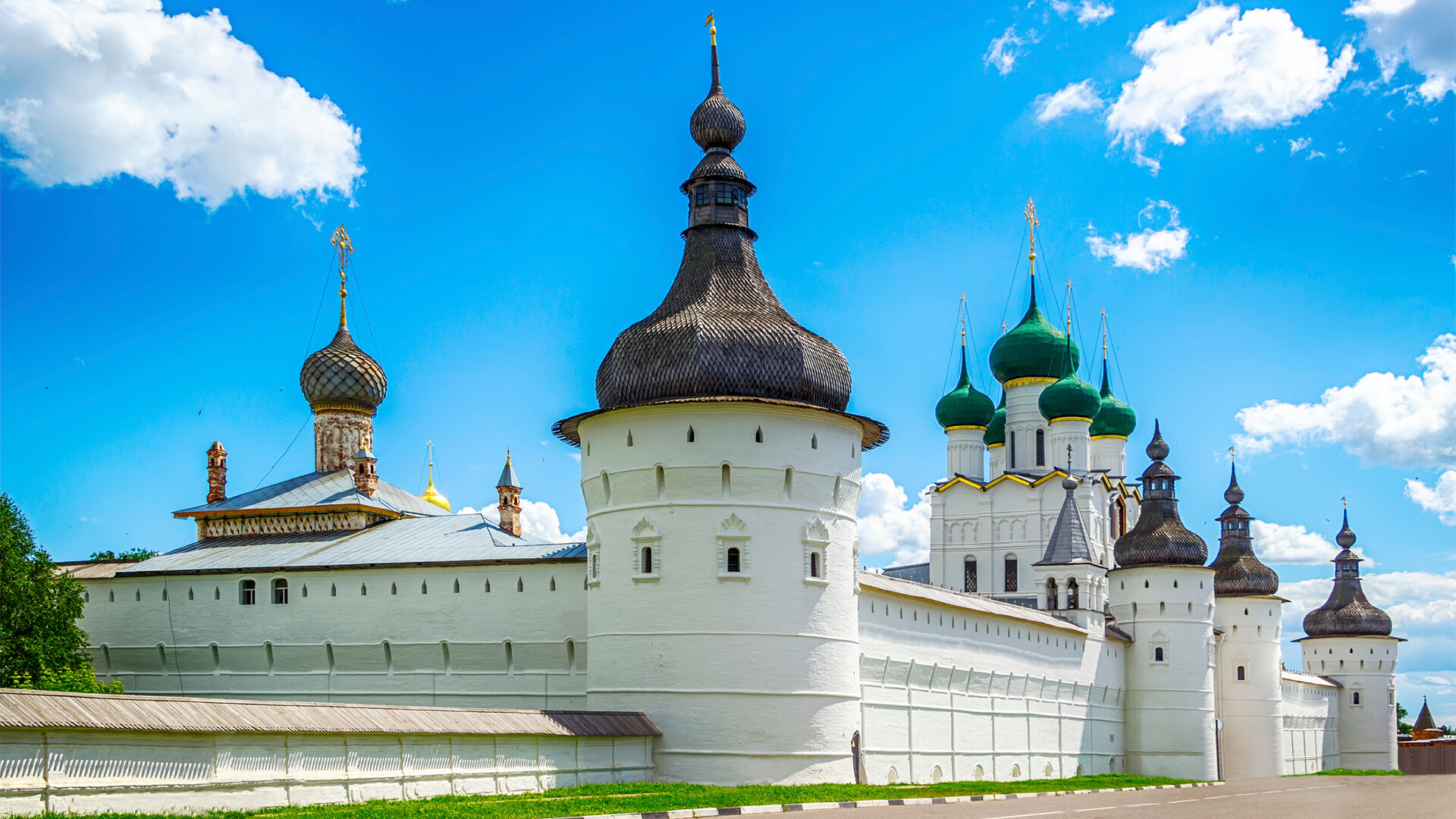
1. H istorical center of Yaroslavl

Church of Elijah the Prophet
Yaroslavl is located at the confluence of the Volga and Kotorosl rivers. This is the capital of the region (and the unofficial capital of the ‘Golden Ring’ tourist route) and a beautiful city with a thousand-year-long history; some of its landmarks are depicted on the 1,000-ruble bill.

The city is, at the same time, very modern – with bars and restaurants to satisfy every taste; that said, it is saturated with history and a rich cultural heritage. So, you can stay awhile and spend quite some time visiting attractions and churches… (don’t miss the Yaroslavl Museum-Reserve and the 17th-century Church of Elijah the Prophet!). You can read a detailed guide of Yaroslavl here .
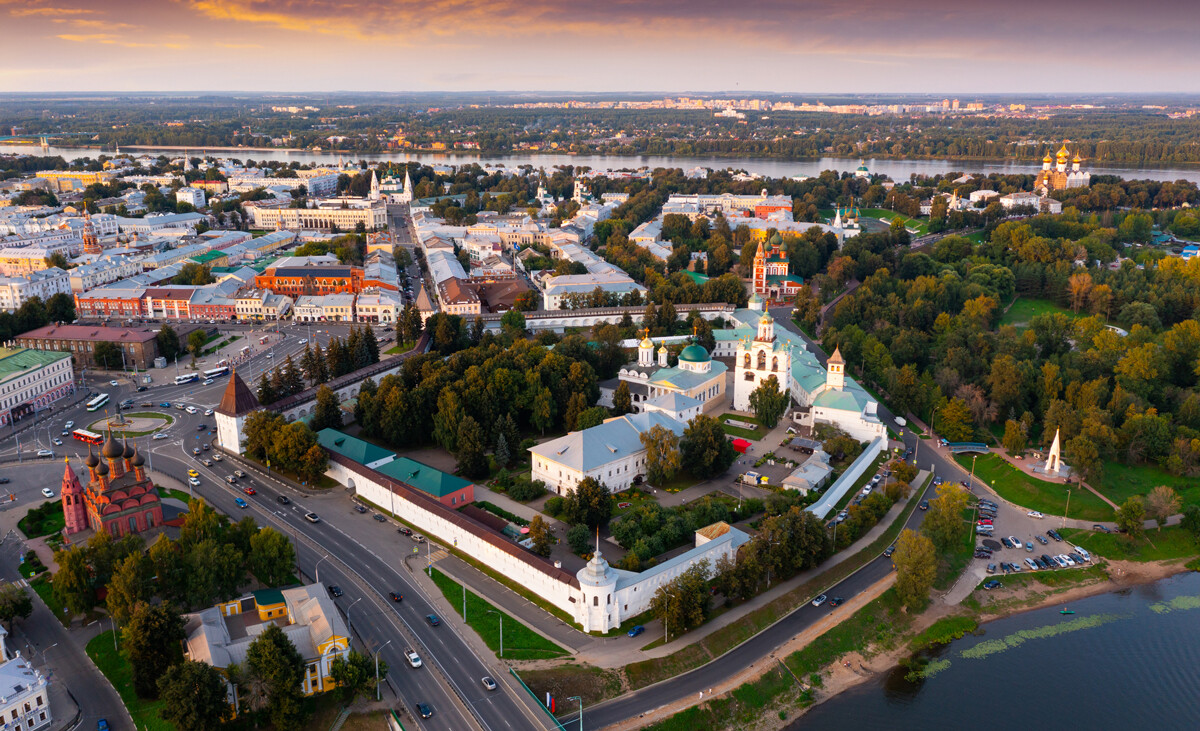
Aerial view of the city center
Even if you don’t like to go to museums, we still recommend you to visit the ‘Golden Ring’ show market, where you can see the main attractions of all the ‘Golden Ring’ cities in one room – well, a miniature version of them! It’s not simply static architecture in miniature, it’s an entire living world. Trains and cars move around, power stations are in operation, you can also hear church bells ring. Night comes every 10 minutes; lights spark up in the cities and in the windows of apartment blocks.

‘Golden Ring’ show market
Such an attraction is fun for both adults and children! You can see more videos and photos here .
2. Pereslavl-Zalessky

The 12th century Transfiguration Cathedral and the monument to Alexander Nevsky
This is the first city of the region along the way for a tourist en route from Moscow to Yaroslavl. It’s also included in the ‘Golden Ring’. Pereslavl-Zalessky has one of the most ancient surviving churches of Russia – the 1152 (!) Transfiguration Cathedral. Almost every house here has a unique “museum” with its own theme, from vintage irons to gramophone records.

Locomotive Museum in Pereslavl
One of the most unusual ones hides in the forests not far from the city – the Pereslavl Railway Museum under the open sky. Examples of different locomotives and coaches since the beginning of the 20th century are collected there. You can also have a ride on a real draisine (a light auxiliary rail vehicle).
You can read a detailed guide to Pereslavl-Zalessky here .
3. Lake Pleshcheyevo
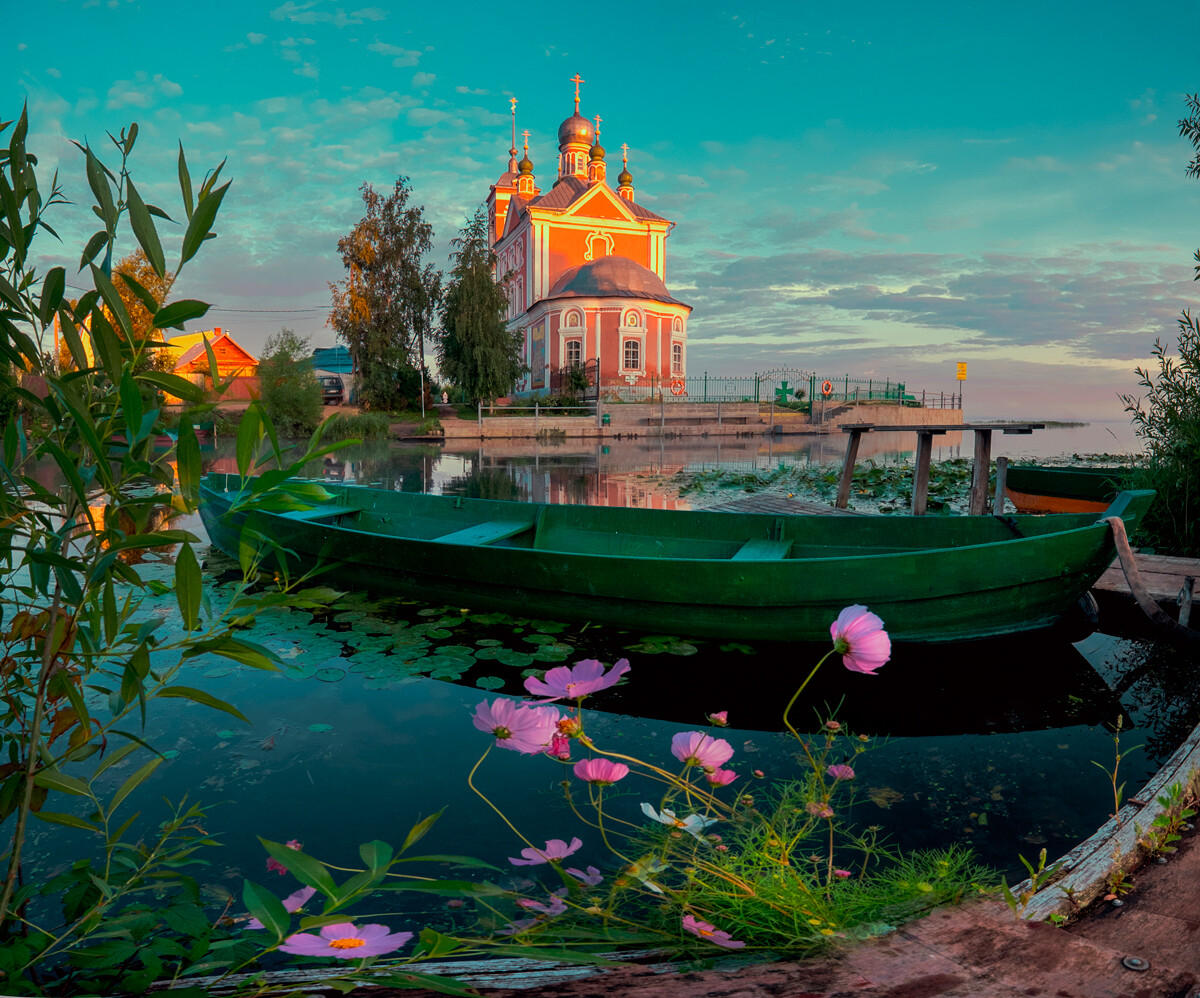
Lake Pleshcheyevo and the Church of the Forty Martyrs
Pereslavl-Zalessky stands on the shore of quite a large body of water. This lake is famous for the fact that Peter the Great trained his amusement fleet there. A museum stands on the shore, where the small boat ‘Fortuna’ is exhibited, built by Peter the Great himself, according to legend.

‘Fortuna’ boat built by Peter the Great
Near Lake Pleshcheyevo lies an ancient artifact of pagan Russia – the sacred ‘Blue Stone’. This is a giant boulder (estimates say it weighs around 12 tons) that changes its color to blue after rain. The locals worshiped the stone in pre-Christian times, but even after accepting Christianity, the stone was attributed mystical properties (it was supposed that the stone possessed dark powers).
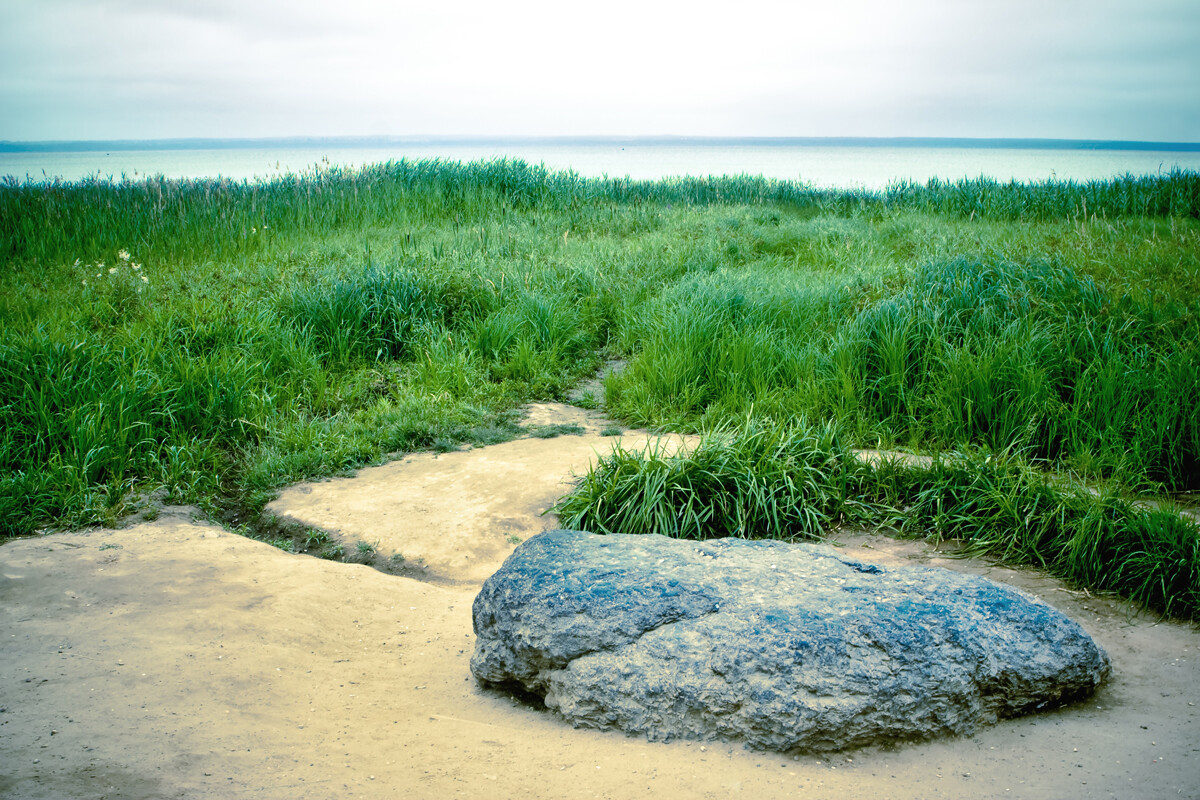
This Blue Stone was considered sacred
Pleshcheyevo is a paradise for eco-tourists; there are a lot of rare birds and animals that livee there, surrounded by a forest and picturesque places. You can stop at one of the recreation bases or pitch a tent and enjoy the view, ride a boat or SUP-boards. There’s also a kiteboarding school; also, during summer, hot air balloon festivals are often held.
4. The Rostov Kremlin
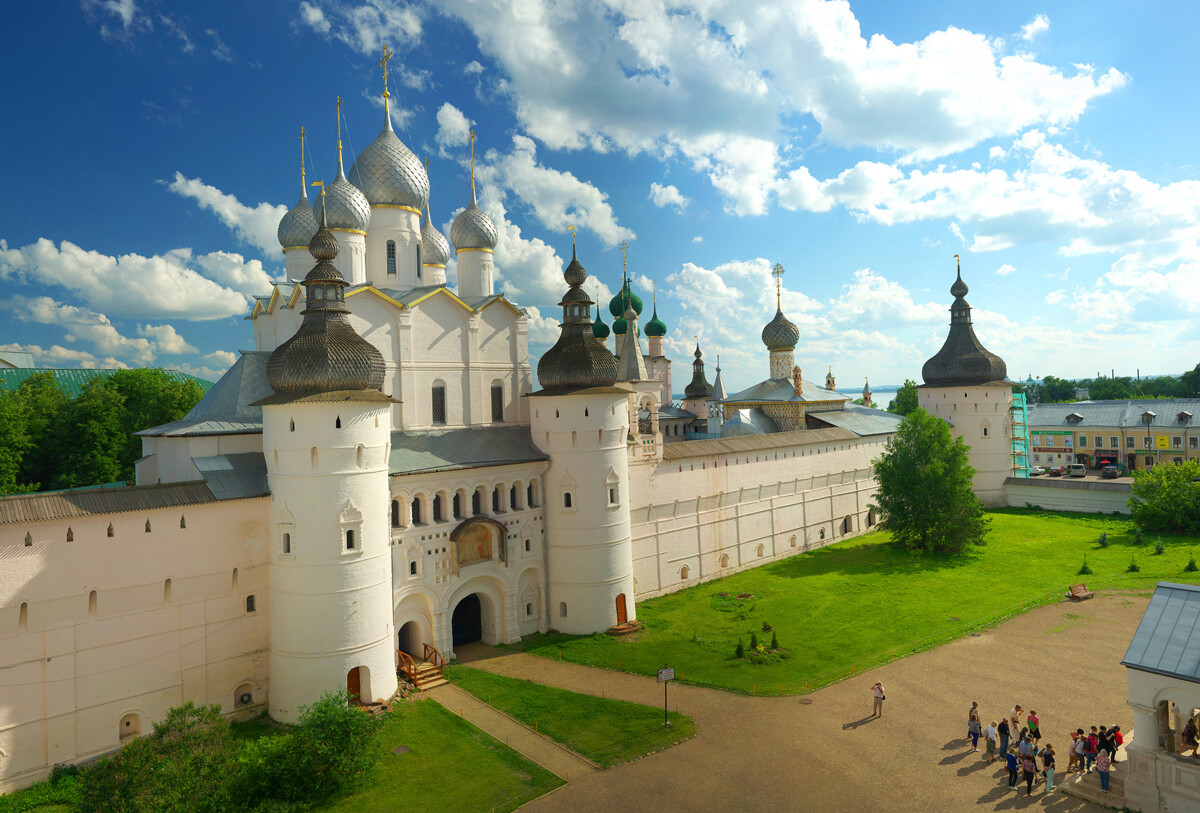
The Rostov Kremlin
The next city along the way is Rostov Veliky (don’t mistake it for the southern Rostov-on-Don). Its main attraction is its unbelievably beautiful white-stone kremlin of. It was also captured in popular culture: many scenes of the iconic comedy movie ‘Ivan Vasilievich: Back to the Future’ were shot there.

A still from ‘Ivan Vasilievich: Back to the Future’
The kremlin is not a defensive fortification like in other cities. It was built as the residence of Rostov metropolitan Jonas III in 1650-1680. The high walls with embrasures and lookout towers are more of a stylization and a tribute to architectural trends.
Inside, you should definitely enter the ancient Dormition Cathedral, admire the iconostasis and frescoes and take a stroll in its picturesque garden. Try pastries with kvass, medovukha or sbiten in the local refectory.
As a souvenir, you can get a decoration item with Rostov ‘finift’, an old local handicraft that originated in Byzantium, involves a technique known as ‘fire writing’.
You can read our Rostov guide here .
5. Uglich – the city where history was made
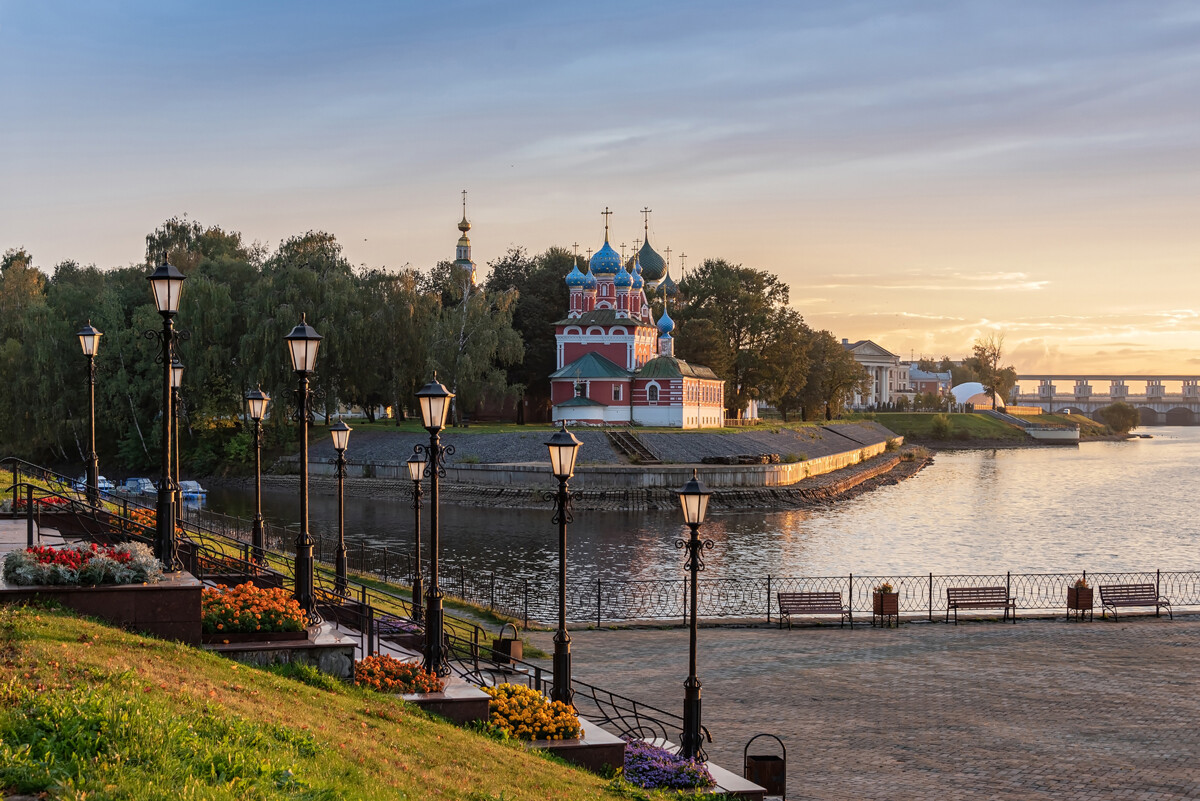
Uglich, the red church is the Church of Dmitry on Spilled Blood
This small town on a picturesque shore of the Volga River is famous across Russia. Not for its ancient churches or its nature, but as the place where Tsarevich Dmitry was killed, which ended the Rurikid dynasty and paved the way for the ‘Time of Troubles’.
The main attractions are concentrated in the kremlin, with a bunch of souvenir stores and a new embankment with trendy cafes.
Visit the chambers of Uglich princes of the 15th century, as well as the Church of Dmitry on Spilled Blood, built on the place where the tsarevich was killed – it has fantastic paintings inside.
And you can read our detailed Uglich guide here .
6. The city of mice
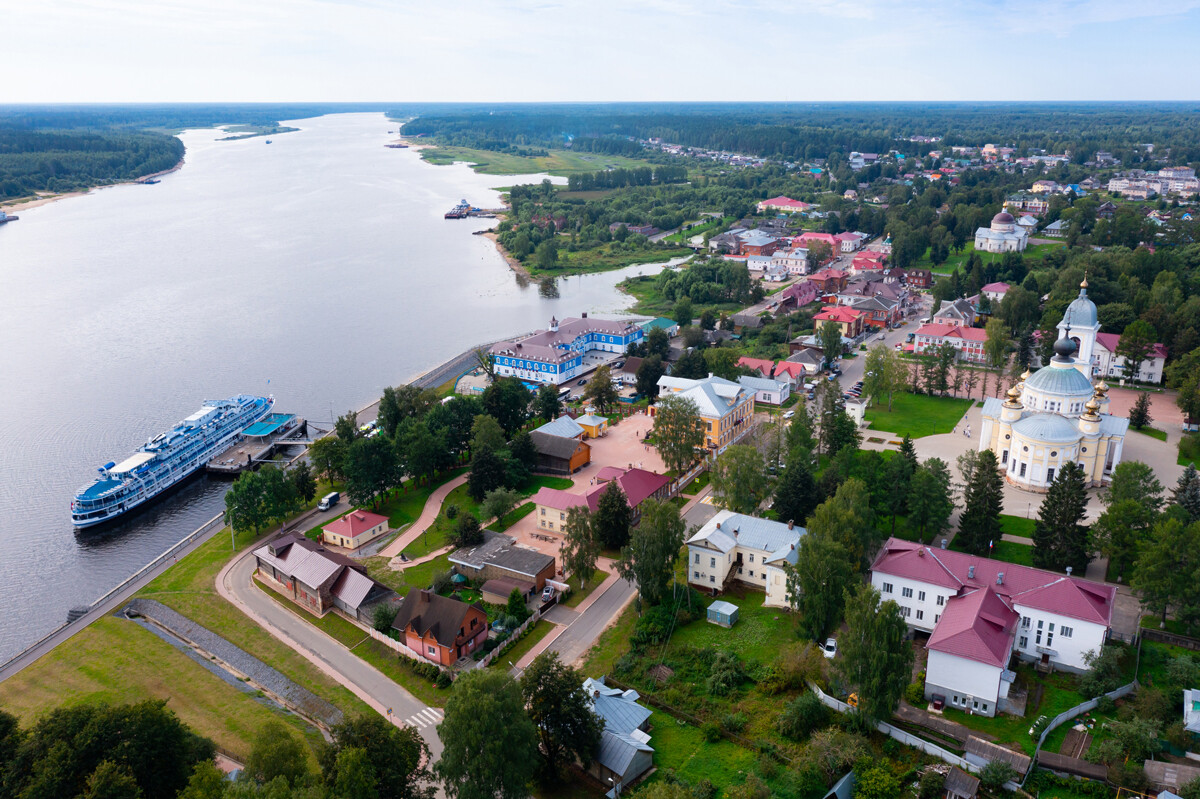
Cruise ships cruising along the Volga River always stop in the city called Myshkin. It is, probably, the most lovely (and cutest) town in the entire region, a small center which has preserved the spirit of Russian antiquity.
‘Mysh’ is Russian for ‘Mouse’, so Myshkin literally means the ‘Mouse City’. Thanks to its name, the city made the mouse its mascot. And now mice (no, not the real ones!) are all over the place – there’s a special museum dedicated to mice, while there are souvenirs wherever you go: mice of the most diverse varieties!

Mice of Myshkin
It’s considered a blessing to buy a small clay mouse and put it in your wallet – the locals believe it will attract money. The square, where the Volga River liners dock, offers a dozen types of smoked fish. A marvelous view of the Volga River, meanwhile, opens from the bell tower of St. Nicholas’ Cathedral.
7. Rybinsk – a retro-style city

Retro street signs on the local Red Square
Rybinsk is yet another city on the shore of the Volga River. There, you can immerse yourself in the atmosphere of rich merchant life – the city was once a true trade center, which also dealt in fish. The Nobel Brothers Museum, who developed the oil industry in the city and on the Volga River, can also be found there.
It’s pure joy to have a stroll in Rybinsk, for, today, the main aspect of the city is that all the signs in the center are made in the retro merchant style. Even modern banks and stores attract visitors with their seemingly pre-revolution signs. Also, Rybinsk has a beautiful and very long embankment and even its own Red Square, which, despite the Lenin monument, is very reminiscent of a typical square somewhere in Europe.
8. The most beautiful village in Russia

The village of Vyatskoye
The village of Vyatskoye 40 kilometers from Yaroslavl is considered one of the most beautiful in Russia (at least, according to the ‘Most Beautiful Villages of Russia’ Association). In recent years, it has become a true Mecca for tourists. Its center was restored in the Art Nouveau style of the beginning of the 20th century, right down to stone pavements and vintage buildings.
There are museums to satisfy every taste (including the Museum of Russian Entrepreneurial Spirit), stores with souvenirs and local delicacies, sweets, and liqueurs, as well as a multitude of cafes.
9. Borisoglebsky Monastery

Borisoglebsky Monastery
There’s an old and very important monastery between Rostov and Uglich. It was founded in 1363 by monks Fyodor and Pavel with the blessing of Sergius of Radonezh himself – who, according to legend, picked this place (he was born not far). The monastery had always been a district center; it was visited by tsars and a village gradually formed around it, after which fairs and trade markets began to be held.
In Soviet times, religious services here stopped and a museum opened instead; but, today, the monastery is operational again. The impressive monastery walls and an imposing gate church speak of its former glory.
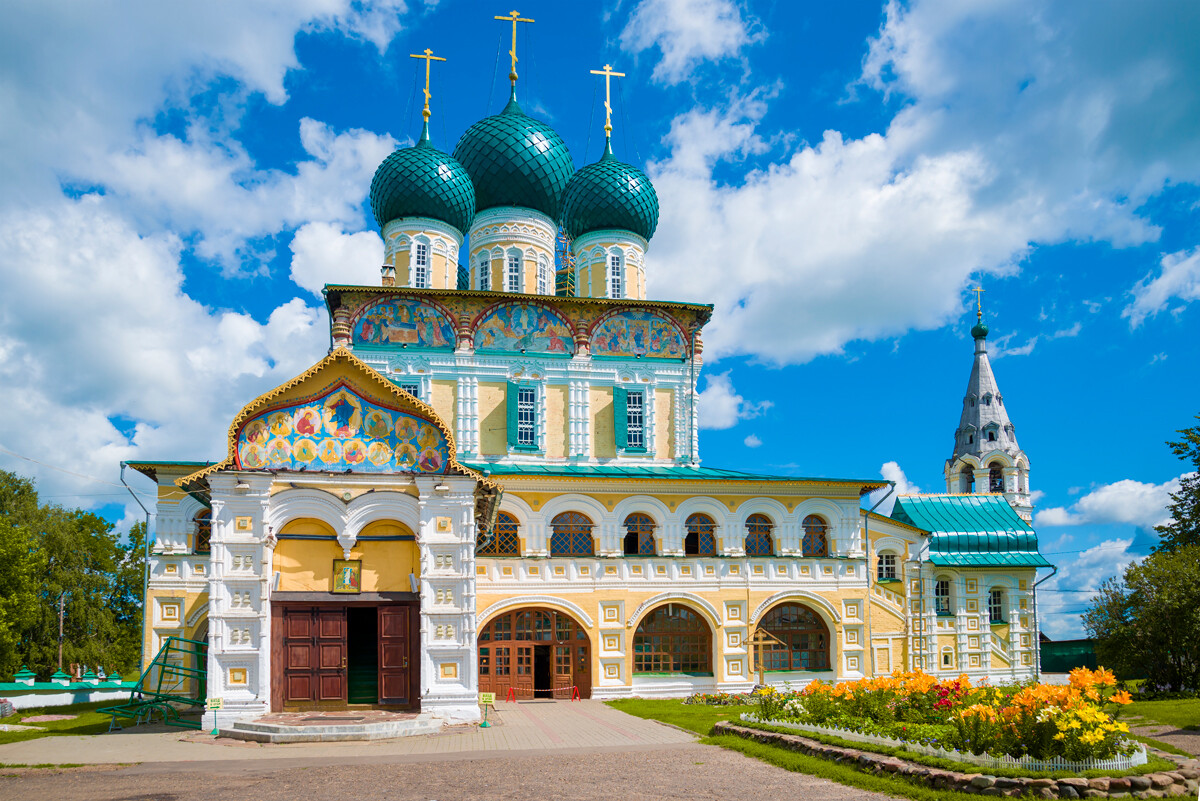
Resurrection Cathedral in Tutaev
This city received its name after the revolution; before, it was called Romanov-Borisoglebsk. It was known for its mineral oil factory, as well as for its linen and fur manufactures (in the 18th century, the breed of Romanov sheep was bred there).
To this day, you can only reach one part of the city from the other only by a ferry, so get ready to sail or pick only one side of the city for your visit. For example, the Borisoglebsk side, with the unbelievably magnificent 17th-century Resurrection Cathedral. Be sure to study the tiled belt and paintings on its facade; inside, you should definitely approach the cathedral’s relic – the unique three-meter-tall Borisoglebsky Savior icon, which is considered miraculous.
Dear readers,
Our website and social media accounts are under threat of being restricted or banned, due to the current circumstances. So, to keep up with our latest content, simply do the following:
- Subscribe to our Telegram channel
- Subscribe to our weekly email newsletter
- Enable push notifications on our website
- Install a VPN service on your computer and/or phone to have access to our website, even if it is blocked in your country
If using any of Russia Beyond's content, partly or in full, always provide an active hyperlink to the original material.
to our newsletter!
Get the week's best stories straight to your inbox
- The 10 most important cities of the Russian North
- 5 MUST-DO experiences in Kaliningrad (PHOTOS)
- 10 most interesting places in Tver Region (PHOTOS)
This website uses cookies. Click here to find out more.

IMAGES
VIDEO
COMMENTS
Add this tour to your saved toursRemove from saved tours star_border star Add to Saved Tours ... Well over 600 species of birds have been recorded here, including all 14 of the Upper Guinea Forest endemics, along with over 200 mammal species, roughly 750 butterflies, over 2,000 higher plant species and around 100 species of reptiles and ...
Férias ou apenas um fim-de-semana de descanso na natureza. Disfrute da envolvência de campos verdes, florestas e ar puro do nosso turismo. Usufrua da piscina ou faça um passeio romântico junto das nossas barragens lindíssimas. Reserve já através de www.natureforestourism.com
Amazon River Cruises & Rainforest Jungle Nature Tours. ANT HighlightVideo ALT. 00:00. 01:51. The Amazon is the explorer's dream from ancient times to the present day... and it can be your dream too... the dream of visiting a continent sized wilderness rainforest where the beasts of legend still roam and where the kingdom of exotic plants reigns ...
Nature Travel. Whether it's a cruise around the Galápagos Islands, a tree house stay in the Amazon rain forest, or a trek in the Himalayas, nature travel gives you unforgettable sights and ...
The tourist information center provides detailed information about the most interesting and memorable places of Yaroslavl, museums, hotels, cafes and restaurants. TIC specialists will help you choose an individual route for traveling around the city and its surroundings. Here a tourist can buy souvenirs of Yaroslavl masters.
Known as "The Nature Island of the Caribbean," Dominica is an obvious choice for those who want to get back to nature. It has an incredibly lush landscape that includes volcanic hot springs, natural mud baths, countless rivers and waterfalls, unspoiled rain forest, and refreshing natural swimming holes.
Best national forests in the U.S. 1. Tongass National Forest, AK. Photograph: Shutterstock. This Alaskan wilderness is filled with huge Sitka spruce, western hemlock and cedar trees, some up to ...
Into the woods. The visit took the team into the woods, more specifically to Chome, Magamba and Amani nature forest reserves, all supported by UNDP through the Enhancing Nature Forest Reserves project (2014-2020). The purpose of the project is to enhance the protection of natural forests in Tanzania through establishing a network of Nature Forest Reserves, the category of protected areas that ...
The Central Suriname Nature Reserve, a UNESCO World Heritage site, comprises over 6,000 square miles of tropical forest. In addition to animals common in the region, such as jaguars, giant ...
When people explore forests and other wild places it can promote greater understanding and appreciation of nature. This in turn fuels environmental protection. Because forest-based tourism often occurs in more rural areas, it also generates important economic benefits for indigenous communities and underserved populations.
Amani Nature Forest Reserve (ANFR) is located in Muheza and Korogwe Districts in Tanga Region. The Nature Reserve covers an area of 8,380 ha and it has tremendous ecological importance with the astonishing African violet flowers ( Saintpaulia) which is believed to have a spiritual aspect (power of forgiveness) and cultural significance.
Your Nature &Adventure Travel Experts. Since 1985, Natural Habitat Adventures has delivered life-enhancing nature and wildlife experiences to small groups of travelers passionate about the natural world. Our unique itineraries are meticulously designed to offer intimate encounters with nature in our planet's most riveting wild destinations ...
By immersing visitors in the wonders of nature, forest-based tourism fosters a deeper understanding and appreciation of forests, igniting a desire to protect them for future generations. This article will delve into the positive impacts of tourism on forest conservation, exploring the economic, ecological, social, and cultural benefits that can ...
How Tourism Benefits Nature and Wildlife. The Great Barrier Reef. Yellowstone. The Amazon Rainforest. One of the top reasons that tourists are drawn to destinations such as these is because of their rich biodiversity and unique landscapes. According to Brand USA, 2 of the top 5 motivators for selecting vacation spots are ecotourism and nature.
Forest tourism is broadly applied to describe a variety of uses of forested landscapes as distinct attractions or environments. It has evolved to encompass product concepts like ecotourism, nature-based tourism, and outdoor recreation. Its unifying element is the recreational use of a forest environment. With trees as the principal attribute ...
Exploring the Shawnee National Forest in Southern Illinois is a great dream for outdoor lovers. Known for its diverse landscapes, many animals, and beautiful nature, this area has some of the best hiking trails in Illinois. One of the best and easiest ways to... Little Grand Canyon in Shawnee National Forest is one of the most loved places to ...
Earlier this year, we published the net zero road map for travel and tourism to reduce our impact in terms of carbon emissions by 50 percent by 2030. Biodiversity is the flip side of that. With ...
The experience is best enjoyed on the package options from different lodges. This means the transfers, meals, accommodation, tours and activities are all taken care of. Choose rainforest lodges to focus on adventure, nature, Mayan ruins or relaxation. As Belize also sits on the coastline, you can enjoy fantastic tropical beaches and cruises to ...
In order to reduce the negative and optimize the positive impacts, new modes and forms of tourism utilizing nature have been developed. These new nature-based forms of tourism include terms such as ecotourism, aiming at sustainable development in tourism. However, at the same time other forms of nature-based tourism have emerged, including ...
Nature Forest Tourism | Martingil, Chamusca, Portugal turismo e descanso na natureza. Contacte-nos por telefone. Ficha de projeto
Top Yaroslavl Parks & Nature Attractions: See reviews and photos of parks, gardens & other nature attractions in Yaroslavl, Russia on Tripadvisor. ... Equestrian Trails • Horseback Riding Tours. What travellers are saying ... Even if you don't have children come here to walk along the river and enjoy the beautiful sight of water and forest as ...
Top Yaroslavl Parks & Nature Attractions: See reviews and photos of parks, gardens & other nature attractions in Yaroslavl, Russia on Tripadvisor.
8. The most beautiful village in Russia. The village of Vyatskoye. Anastasia Stepanova/Museumfest.ru. The village of Vyatskoye 40 kilometers from Yaroslavl is considered one of the most beautiful ...